AMD Announces Threadripper HEDT and Pro 7000-Series CPUs: 96 cores and 192 threads for Desktops and Workstations
AMD’s fire-breathing $10,000 96-core 192-thread chip barrels into the market.
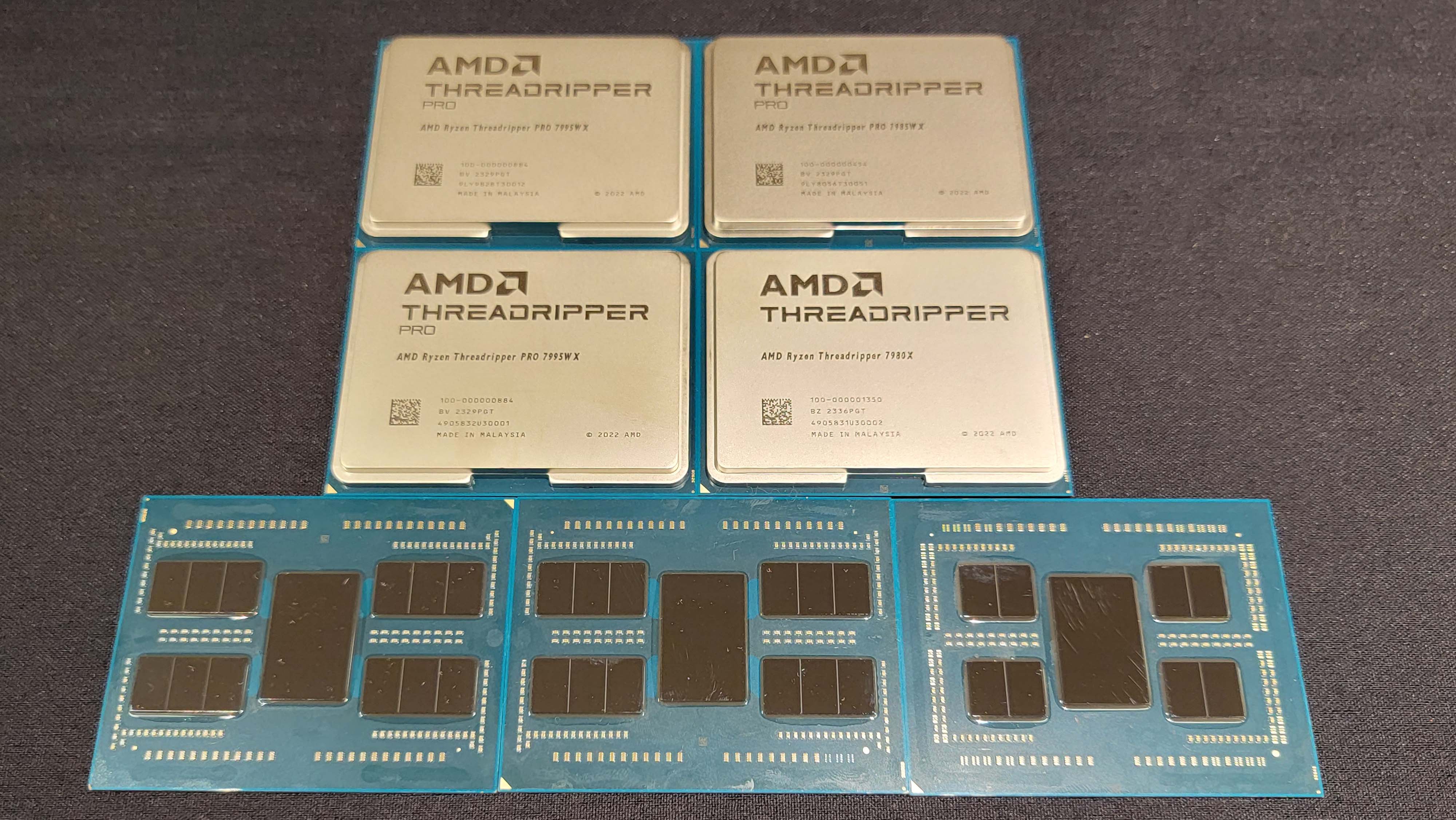
Last year, AMD announced that it would exit the HEDT market, but the company reversed course today as it announced two new families of 'Storm Peak' Threadripper processors, the Threadripper 7000-series CPUs for the HEDT market and the Threadripper Pro 7000 WX-series for the workstation market, looking to maintain Threadripper’s spot at the top of our list of best CPUs for workstations. AMD claims its new HEDT chips offer up to 94% more performance than Intel’s competing Xeon w9-3495X flagship and up to 46% more performance than its own prior-gen Threadripper Pro 5995WX, setting the stage for a new level of high-end performance for the desktop PC market. If cost is no object, you can even snap in a 96-core 192-thread Pro series processor into the new HEDT platform.
AMD’s WX-series lineup, which starts at $10,000, also looks promising — AMD says its new 96-core workstation processor provides up to 223% faster rendering performance in V-Ray than Intel’s competing flagship. Of equal importance, AMD also touts up to 73% lower power consumption per core and a 2.2X better performance-to-power ratio than Intel’s chips. Both series of processors will debut on November 21 as both Products in Box (PIB) chips at retail for DIYers and in OEM systems.
| Row 0 - Cell 0 | MSRP/SEP | Cores / Threads | Base / Boost (GHz) | L3 Cache (MB) | TDP | PCIe | Memory |
| Threadripper 7980X | $4,999 | 64 / 128 | 3.2 / 5.1 | 256 MB | 350W | 48 (5.0) / 32 (4.0) | Four-Channel DDR5-5200 (RDIMM) |
| Threadripper 7970X | $2,499 | 32 / 64 | 4.0 / 5.3 | 128 MB | 350W | 48 (5.0) / 32 (4.0) | Four-Channel DDR5-5200 (RDIMM) |
| Threadripper 7960X | $1,499 | 24 / 48 | 4.2 / 5.3 | 128 MB | 350W | 48 (5.0) / 32 (4.0) | Four-Channel DDR5-5200 (RDIMM) |
AMD’s standard HEDT series consists of three chips, led by the 64-core 128-thread Threadripper 7980X that will retail for $4,999. The last generation of Threadripper HEDT chips featured the Zen 2 architecture on the 7nm node and peaked at 4.5 GHz, but the new family leaps forward to Zen 4 on the 5nm node and peaks at 5.3 GHz. AMD also updated its I/O to quad-channel DDR5-5200 memory, 48 lanes of PCIe 5.0, and 32 lanes of PCIe 4.0.
| Row 0 - Cell 0 | Row 0 - Cell 1 | Cores / Threads | Base / Boost (GHz) | L3 Cache (MB) | TDP | PCIe | Memory |
| Threadripper Pro 7995WX | $9,999 | 96 / 192 | 2.5 / 5.1 | 384 MB | 350W | 128 (5.0) / 8 (4.0) | Eight-Channel DDR5-5200 (RDIMM) |
| Threadripper Pro 7985WX | $7,349 | 64 / 128 | 3.2 / 5.1 | 256 MB | 350W | 128 (5.0) / 8 (4.0) | Eight-Channel DDR5-5200 (RDIMM) |
| Threadripper Pro 7975WX | $3,899 | 32 / 64 | 3.2 / 5.3 | 128 MB | 350W | 128 (5.0) / 8 (4.0) | Eight-Channel DDR5-5200 (RDIMM) |
| Threadripper Pro 7965WX | $2,649 | 24 / 48 | 4.2 / 5.3 | 128 MB | 350W | 128 (5.0) / 8 (4.0) | Eight-Channel DDR5-5200 (RDIMM) |
| Threadripper Pro 7955WX | ? | 16 / 32 | 4.5 / 5.3 | 80 MB | 350W | 128 (5.0) / 8 (4.0) | Eight-Channel DDR5-5200 (RDIMM) |
| Threadripper Pro 7945WX | ? | 12 / 24 | 4.7 / 5.3 | 76 MB | 350W | 128 (5.0) / 8 (4.0) | Eight-Channel DDR5-5200 (RDIMM) |
The workstation lineup has seven chips, headlined by the flagship 96-core 192-thread Threadripper Pro 7795WX. The last generation of AMD's workstations chips featured the Zen 3 architecture on 7nm with up to 4.5 GHz, while the new 7000 WX-series moves to the Zen 4 architecture on 5nm with peak clock speeds of 5.3 GHz. These chips support eight channels of DDR5-5200 memory and up to 128 lanes of PCIe 5.0 and eight lanes of PCIe 4.0. AMD hasn’t shared pricing for its workstation models yet, but it will share those details when the chips come closer to market. However, Newegg has listed the chips for the following price:
- · AMD Ryzen Threadripper PRO 7995WX: $9,999
- · AMD Ryzen Threadripper PRO 7985WX: $7,349
- · AMD Ryzen Threadripper PRO 7975WX: $3,899
- · AMD Ryzen Threadripper PRO 7965WX: $2,649
AMD’s new WRX90 platform will house the Pro processors, while the cost-optimized TRX50 will slot in for the HEDT platform with support for both the Pro and HEDT processors. Both platforms come with the sTR5 socket, so they aren’t quite as large as AMD’s beastly EPYC Genoa processors. This socket and chips are the same size as the sTRX4/TR4 sockets for the previous-gen Threadripper, but they aren’t electrically compatible. AMD's ability to cram 96 cores into the same-sized package that originally housed 16 cores in 2017 is simply phenomenal, marking yet another engineering feat.
AMD has a full roster of both global and regional OEM partners that will bring full systems to the market, and chips and motherboards will also be available at retail, with the latter coming from the likes of Gigabyte, ASUS, MSI, and ASRock.
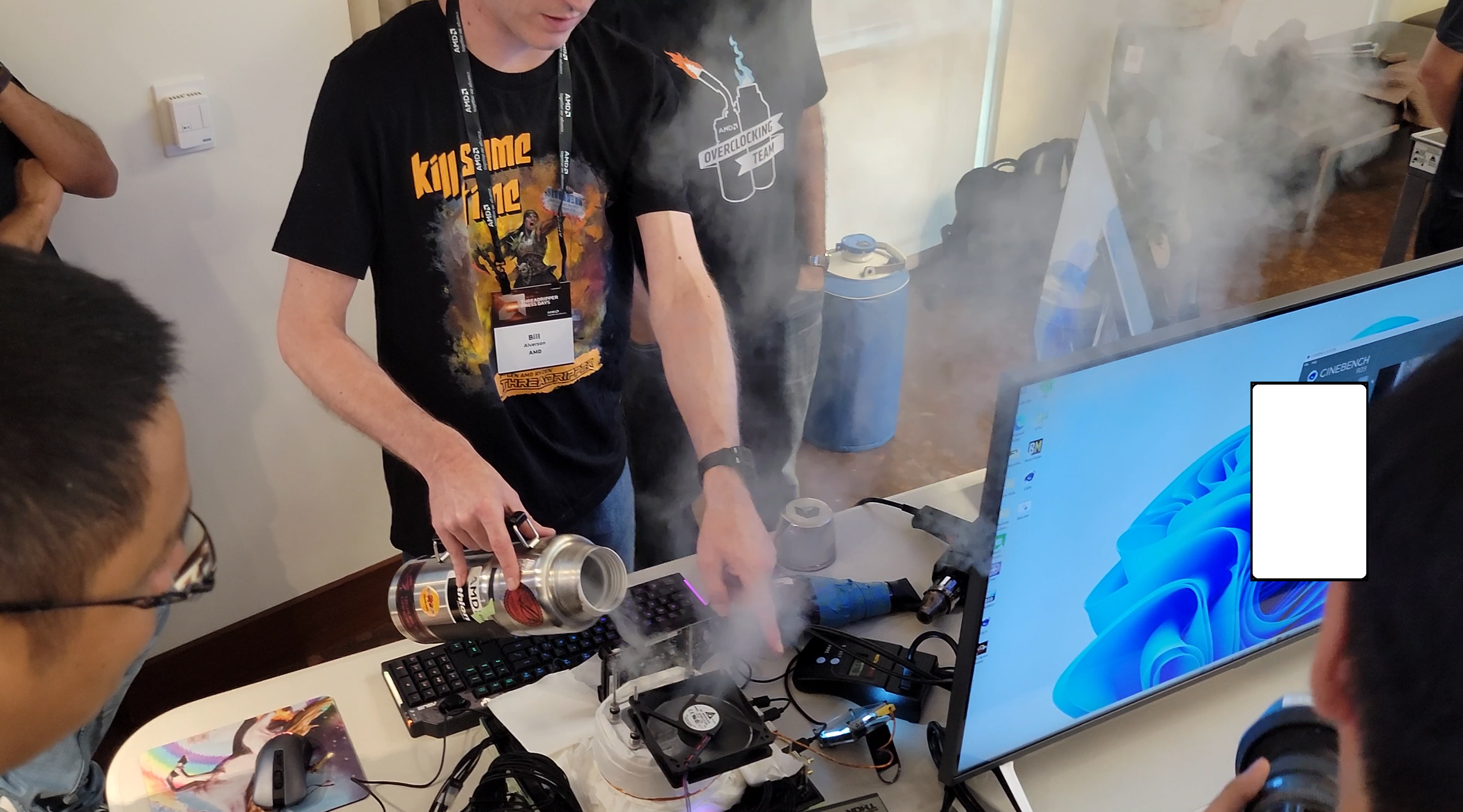
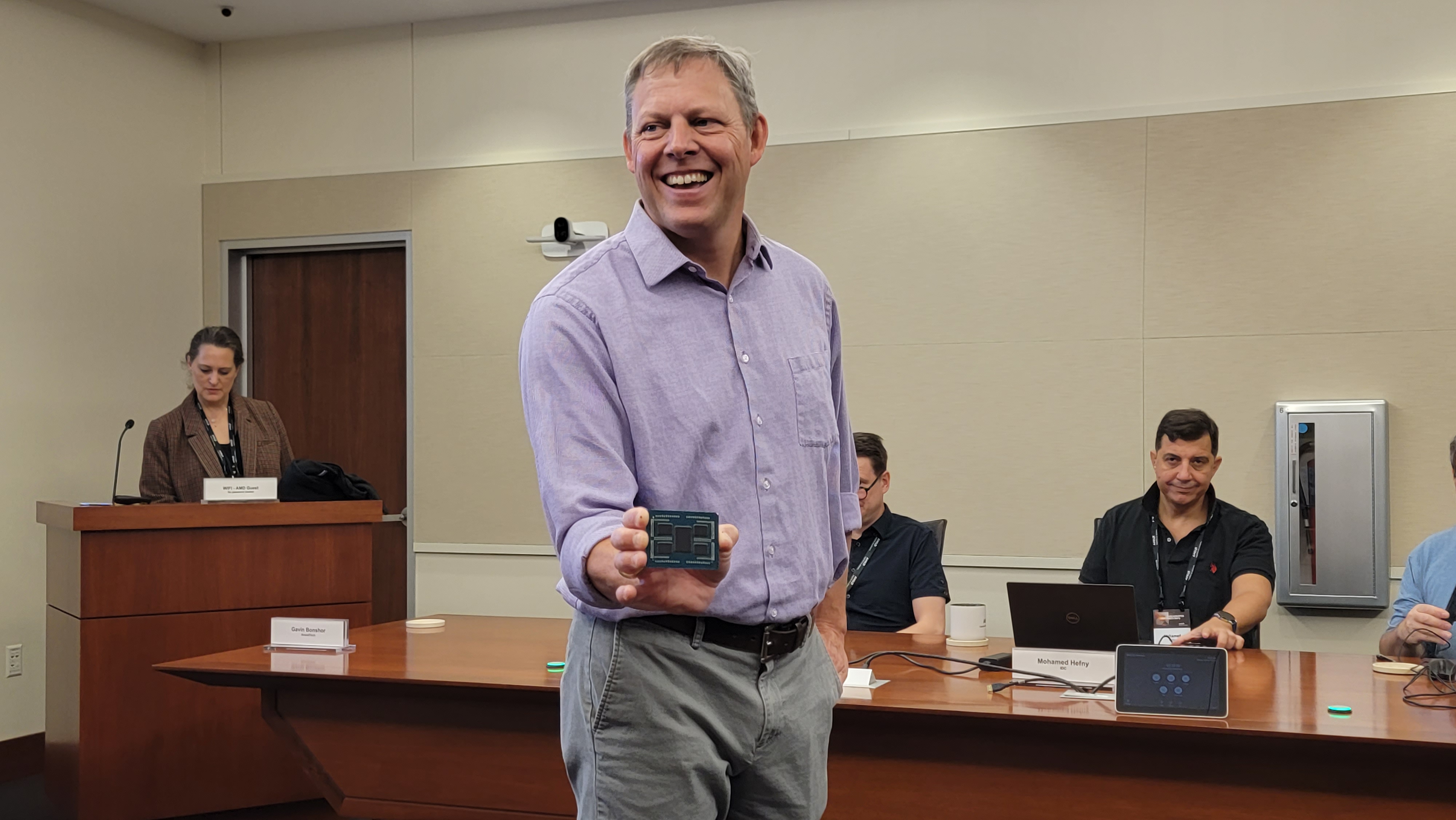
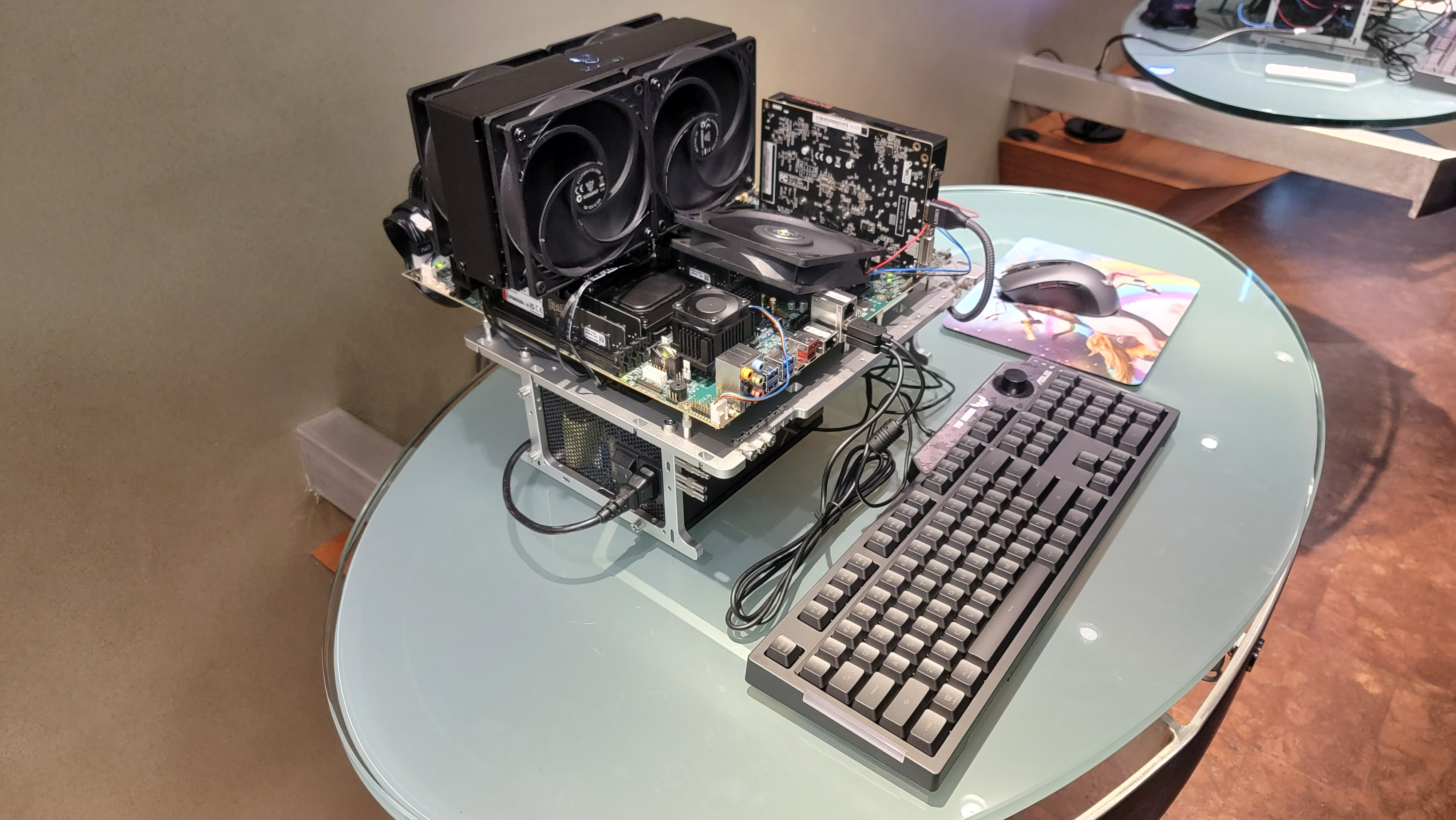
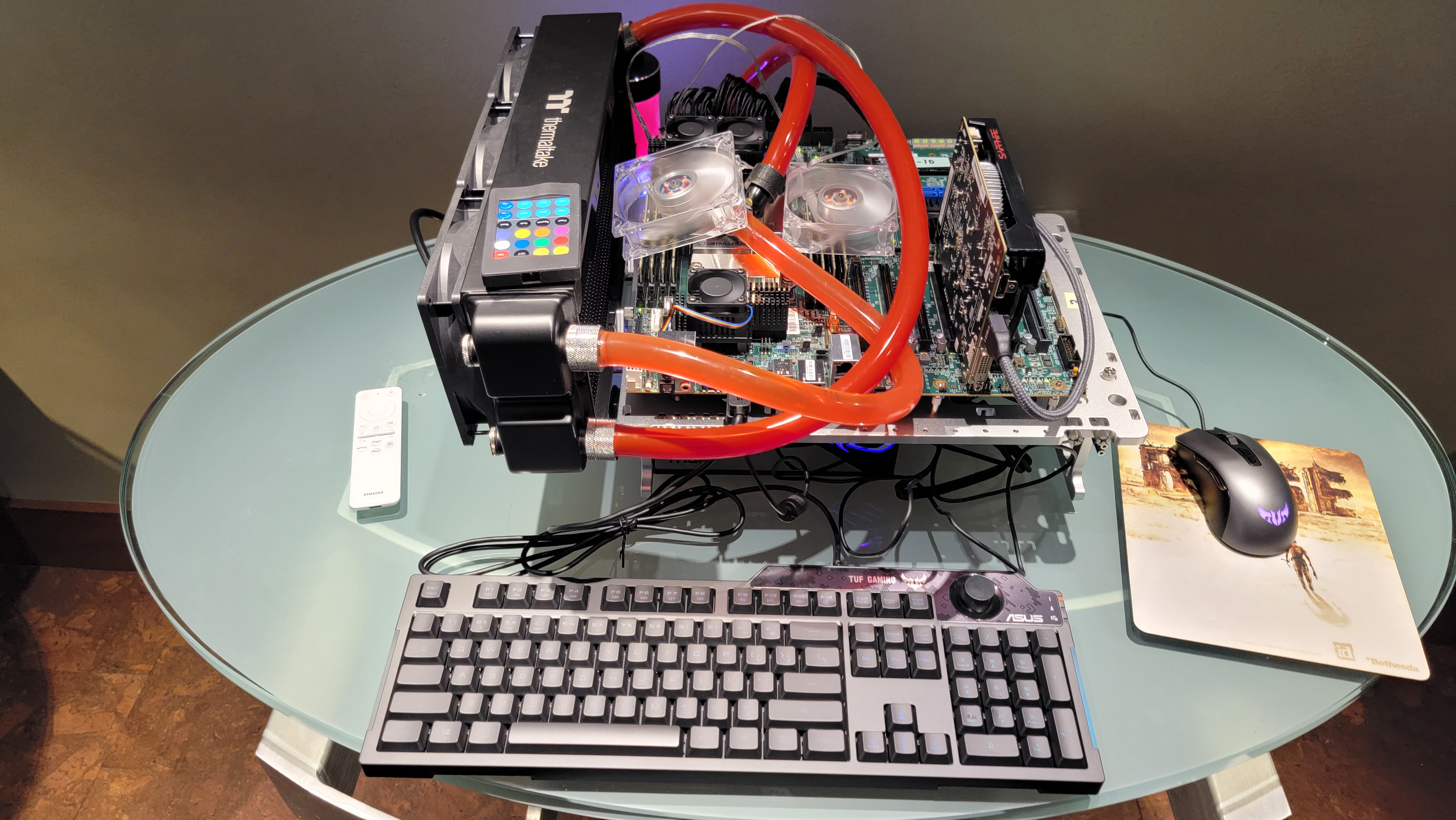
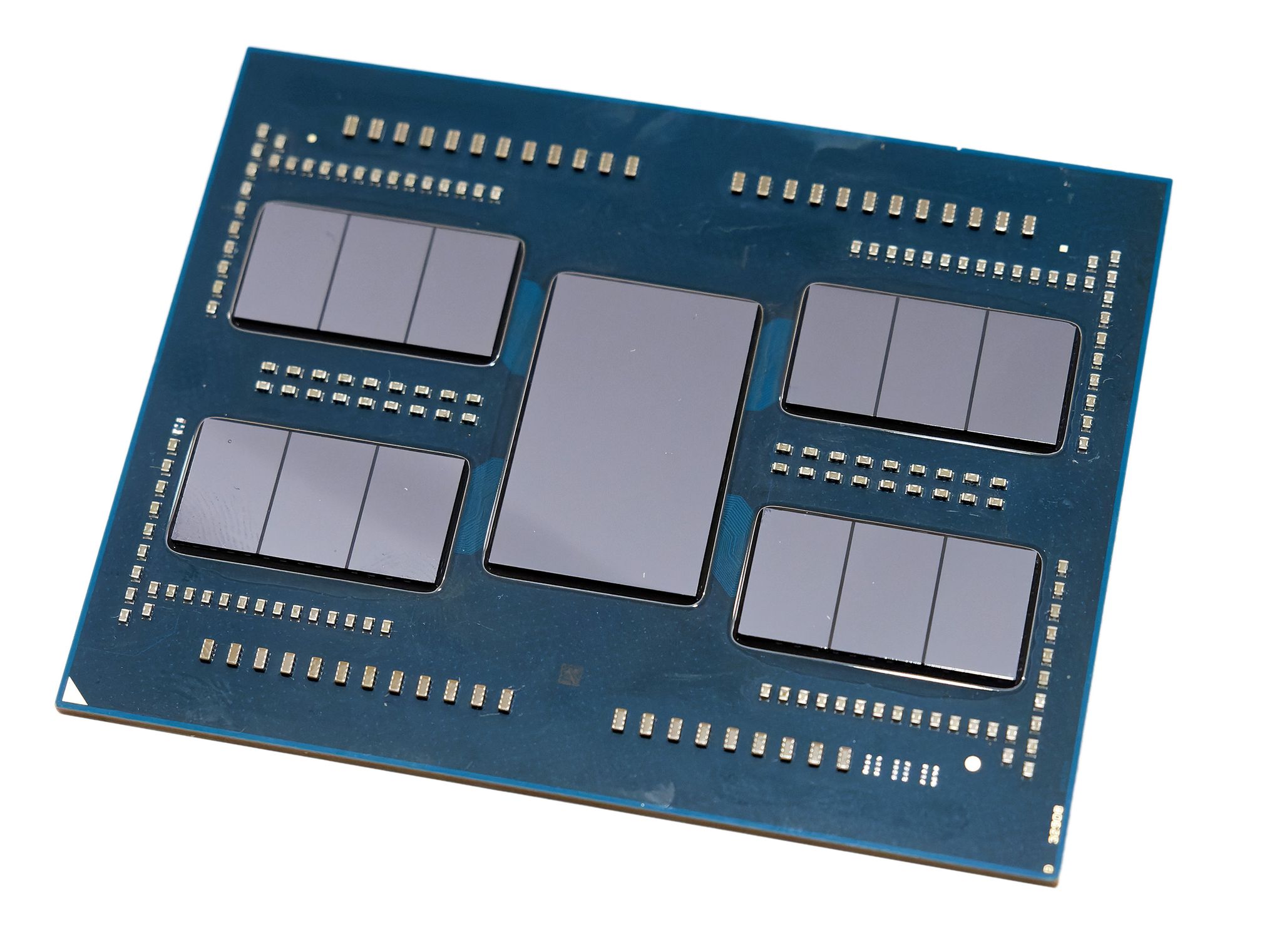
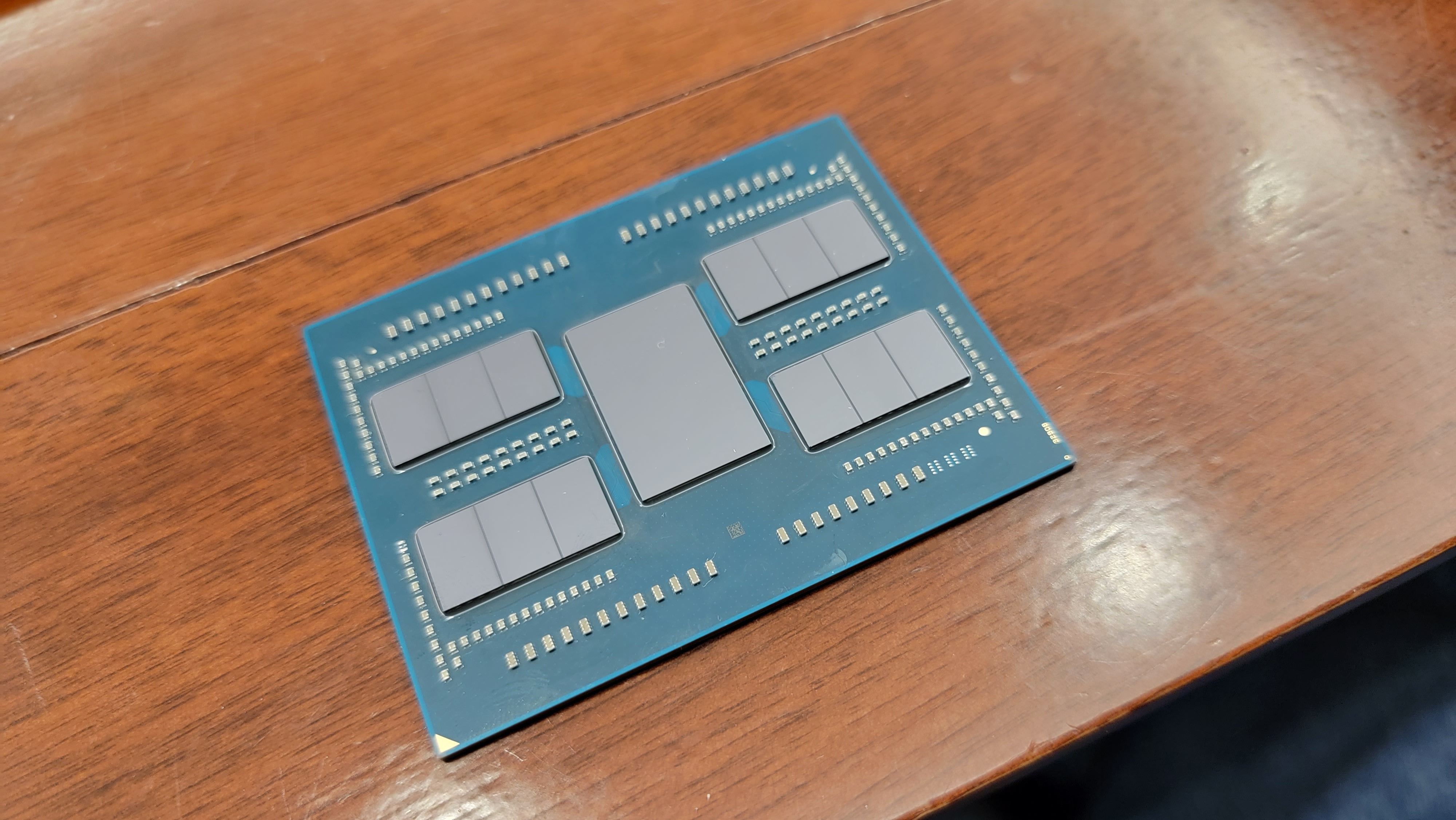
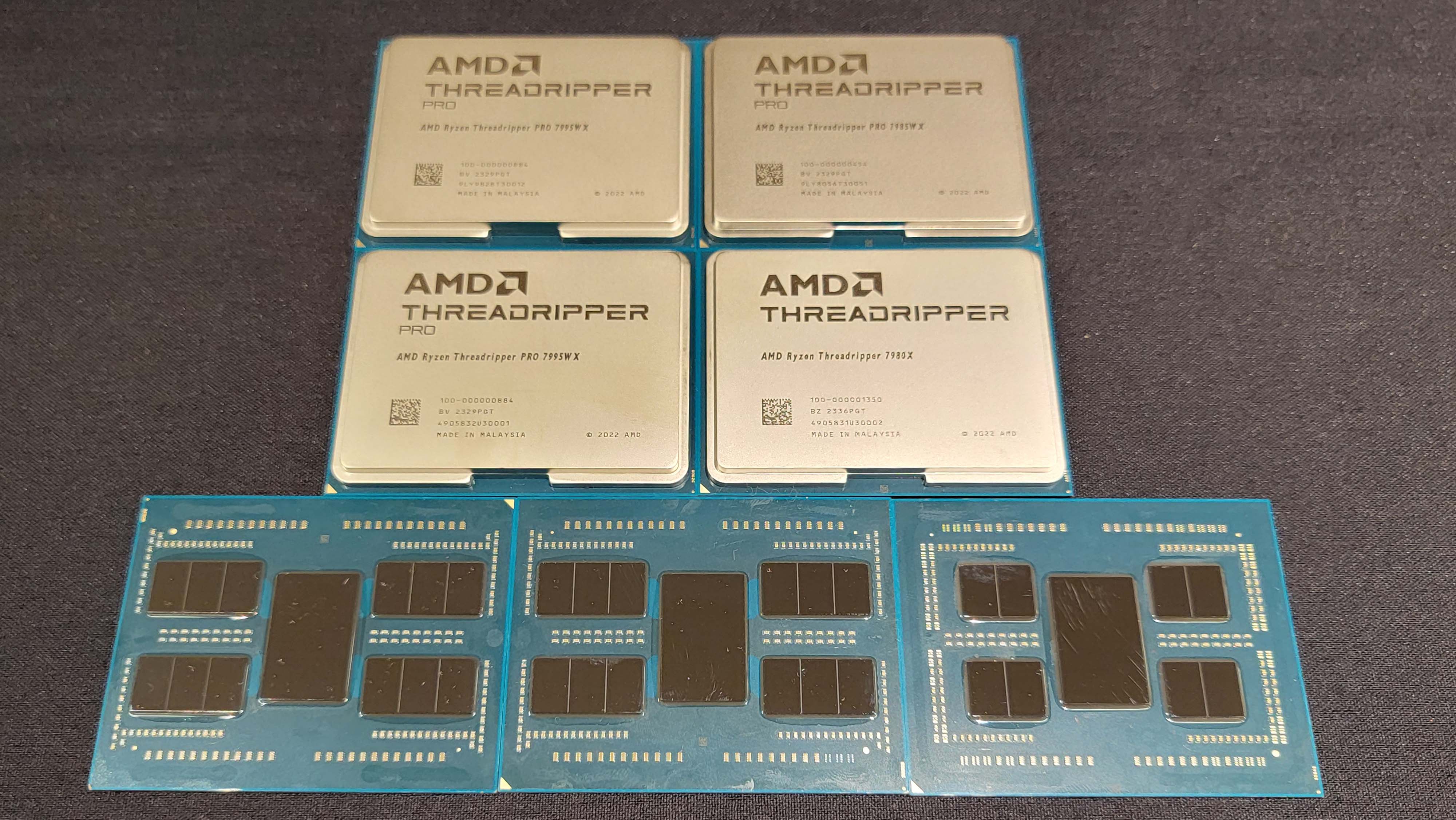
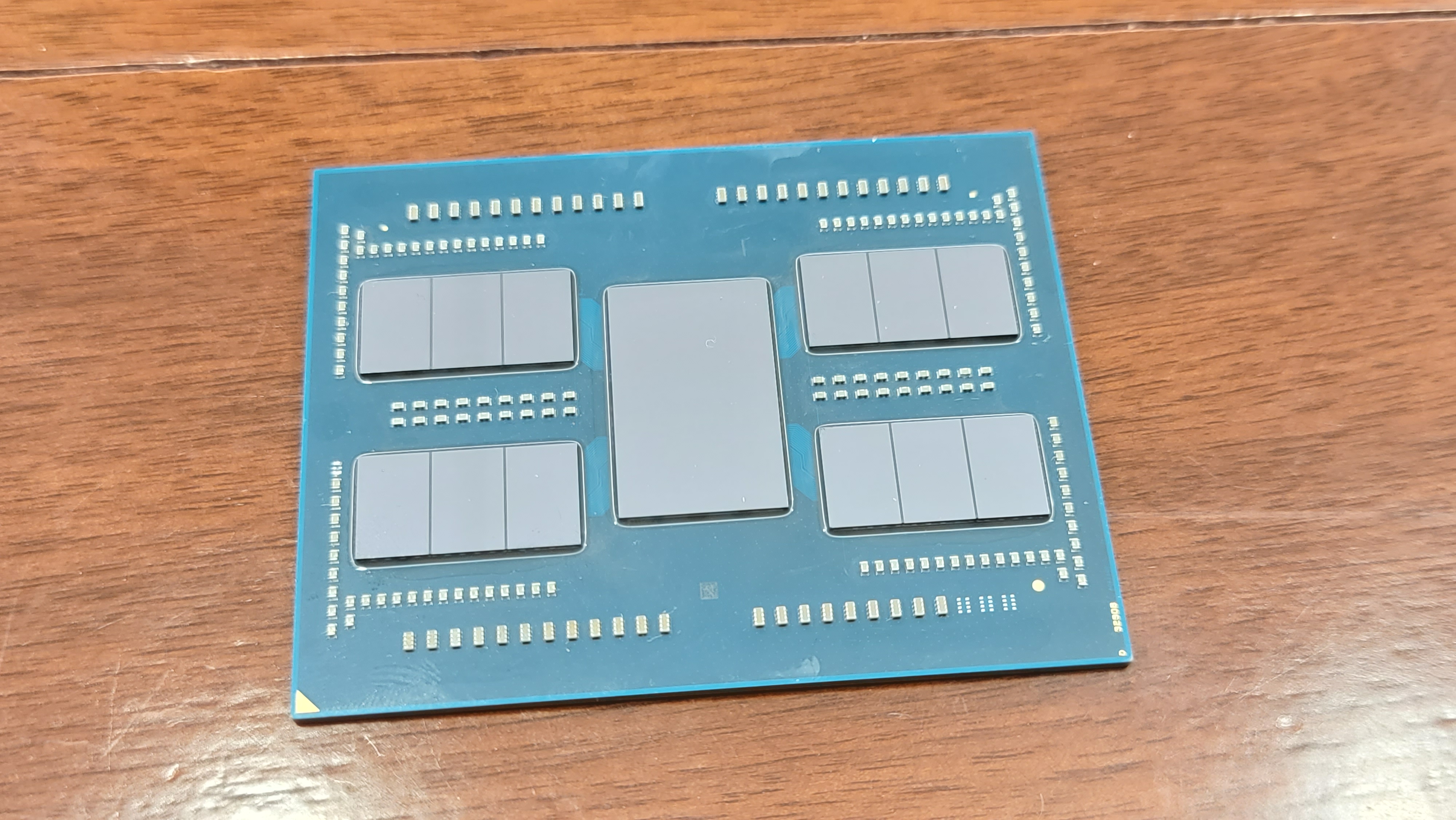
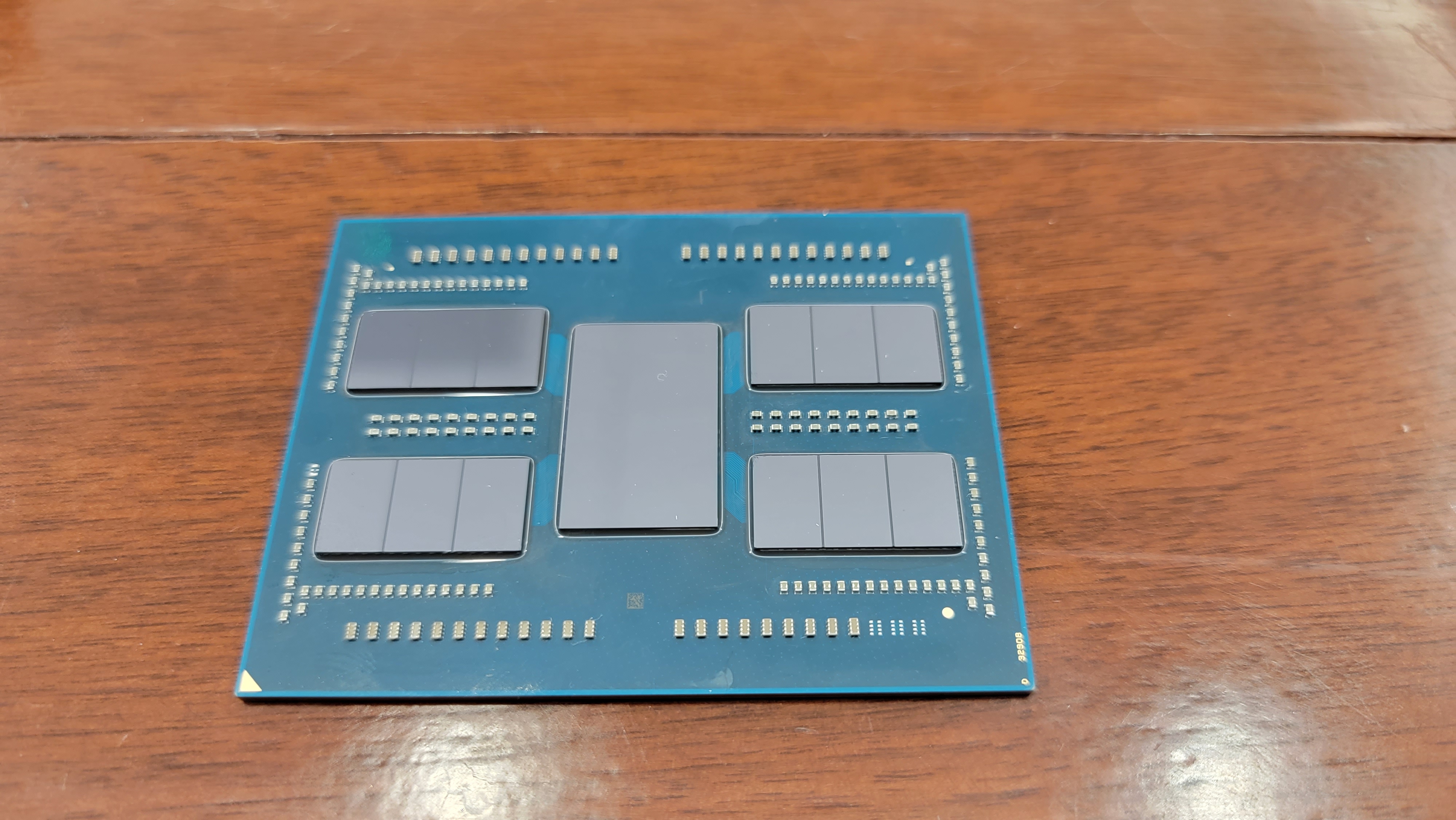
Yes, both series of processors are fully overclockable, and AMD shared plenty of details about both new families of chips and demoed some completely mind-bending benchmarking action at a recent press day in Austin, Texas — rest assured, these chips will place in the upper echelons of our CPU benchmarks hierarchy. Unfortunately, we can’t share the results of those benchmarks yet, but we do have plenty of information we can share in advance. We’ll cover the two processor lineups and then move on to the chip architecture and supporting platforms. Let’s dive in.
Ryzen Threadripper 7000-Series HEDT Specifications and Pricing
Last year, AMD famously announced that it would only release Threadripper Pro models, thus exiting the HEDT market, but the company tells us that decision was spurred by a host of headwinds that have since subsided, like supply shortages and skyrocketing motherboard pricing. With those factors now normalized, AMD decided to re-enter the HEDT space, but its new lineup isn’t necessarily aimed square at the gamer crowd like the Threadripper HEDT chips of old. In fact, AMD’s marketing materials for its new HEDT chips aren’t geared toward gamers, and the company didn’t share any gaming benchmarks. (You can rest assured that we'll test them in gaming, though.)
In many respects, that makes plenty of sense — today’s highest-end 16-core Ryzen 9 and 20-core Intel 9 mainstream desktop chips are really ‘mainstream’ in name only, as they offer more than enough threaded horsepower for even the most demanding gamers. However, a subset of customers want more PCIe connectivity and memory capacity/throughput, but in a smaller form factor that’s more affordable than full-fledged workstations. That’s where the new HEDT lineup slots in, but pricing for both the chips and the required ECC memory (RDIMMS) will likely relegate these systems to the professional and semi-professional markets.
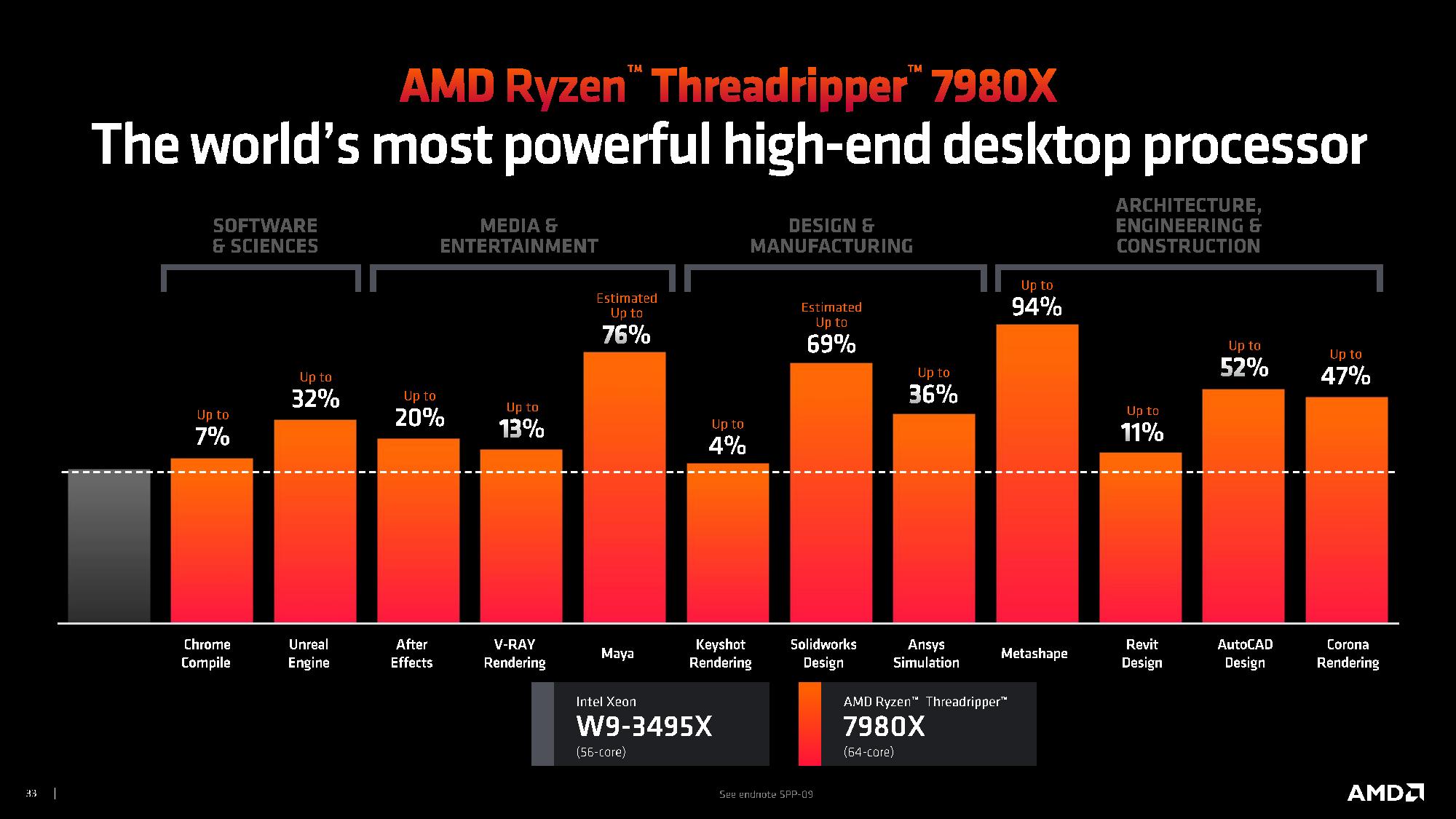
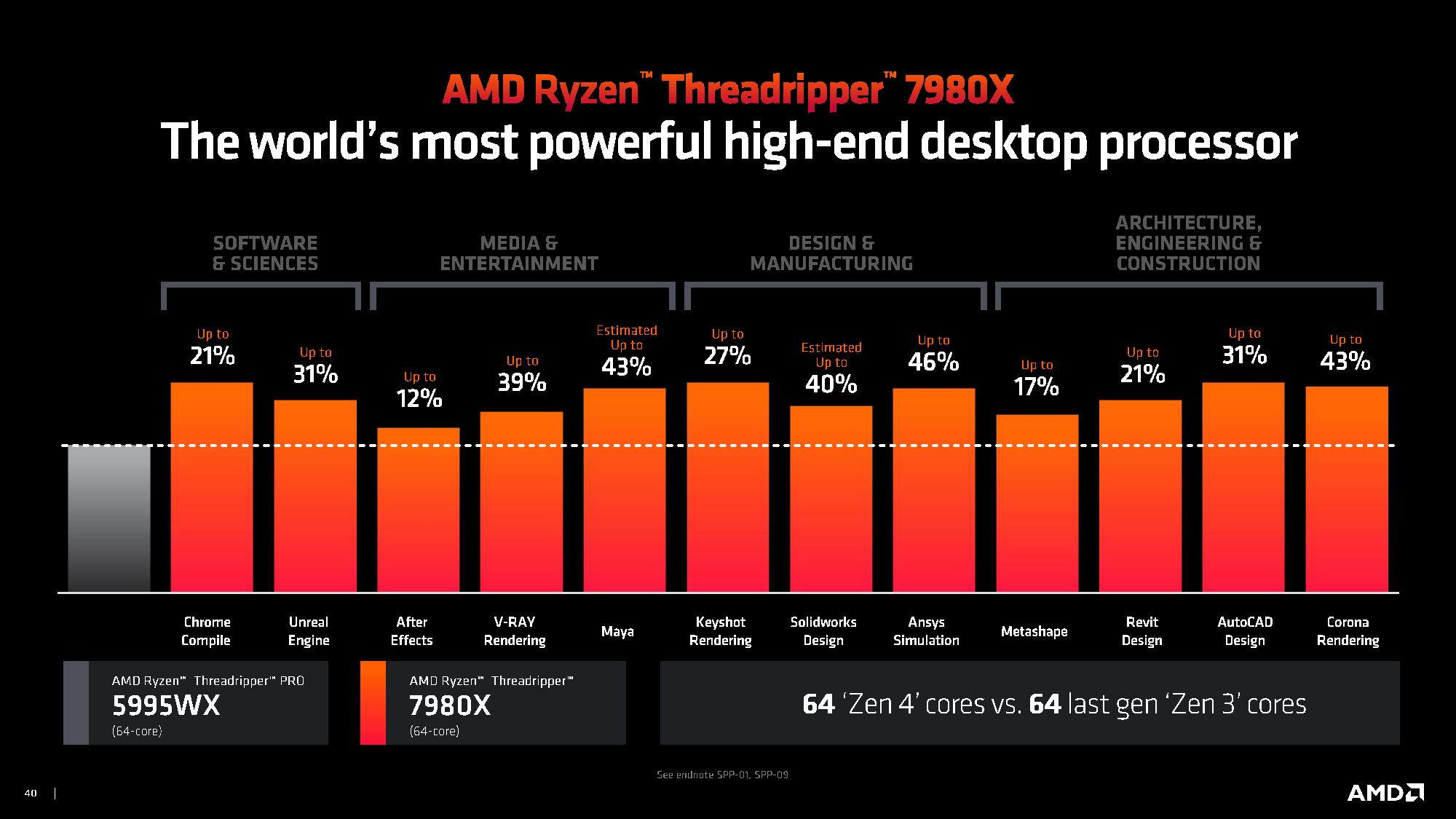
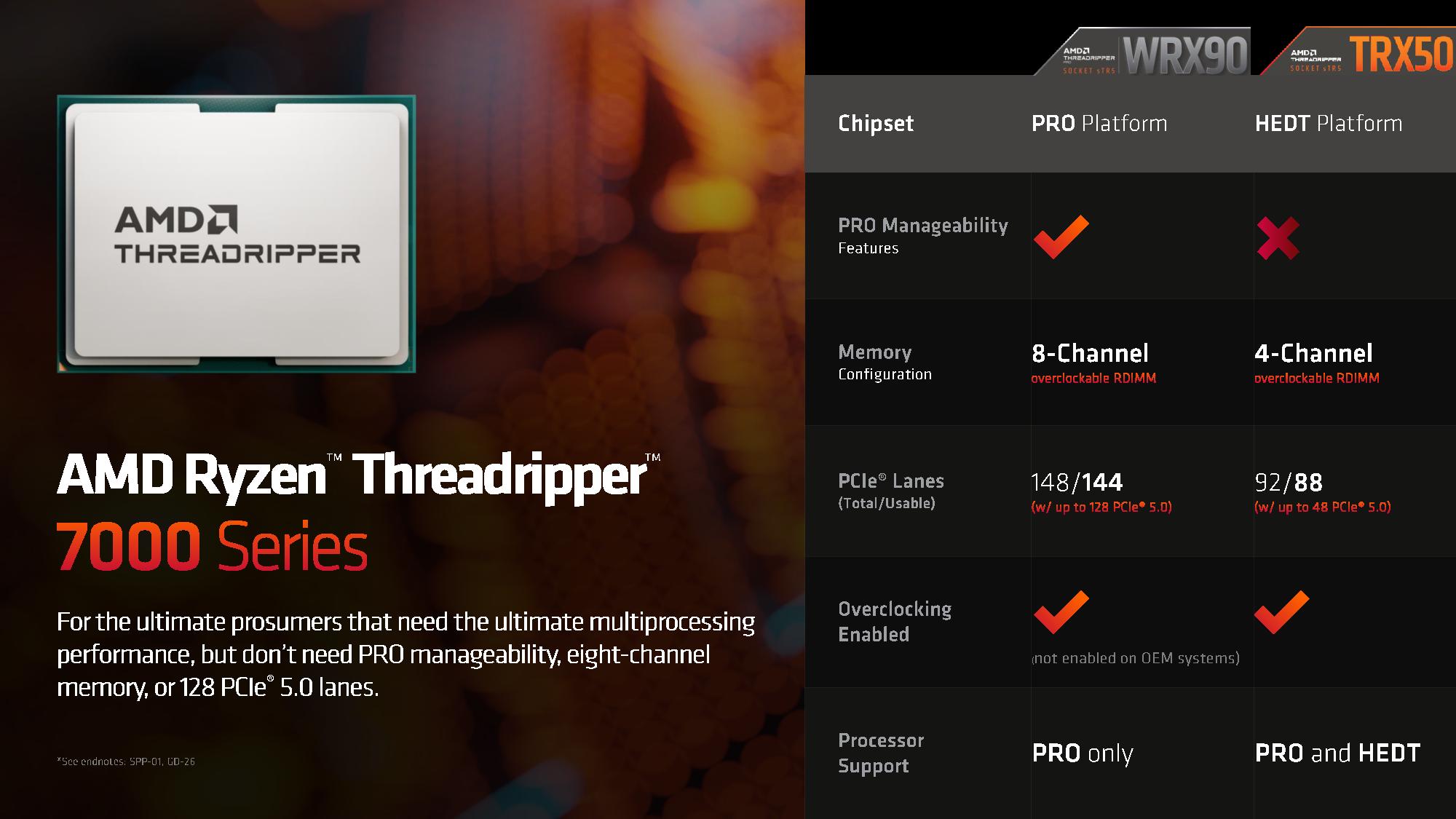
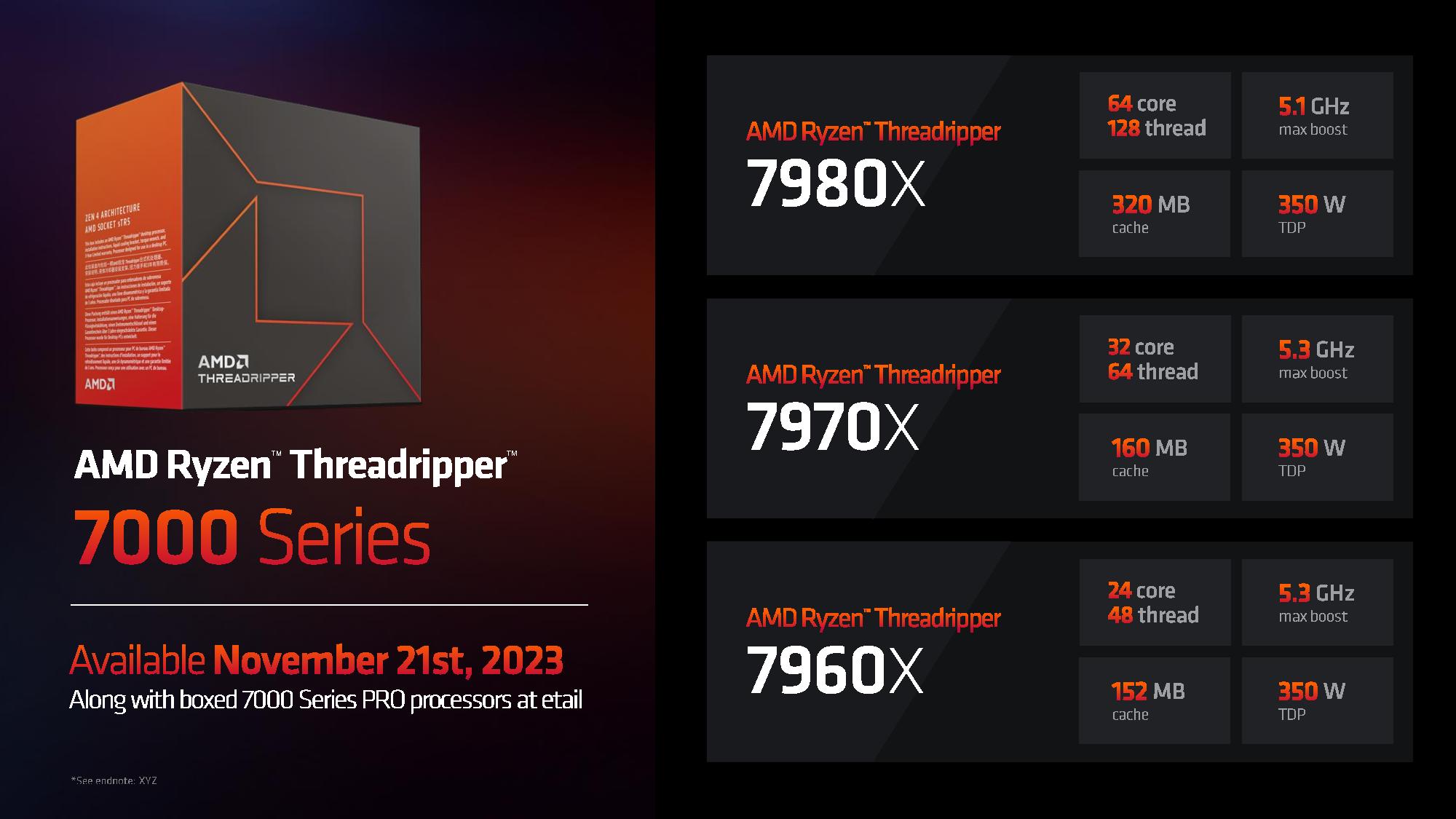
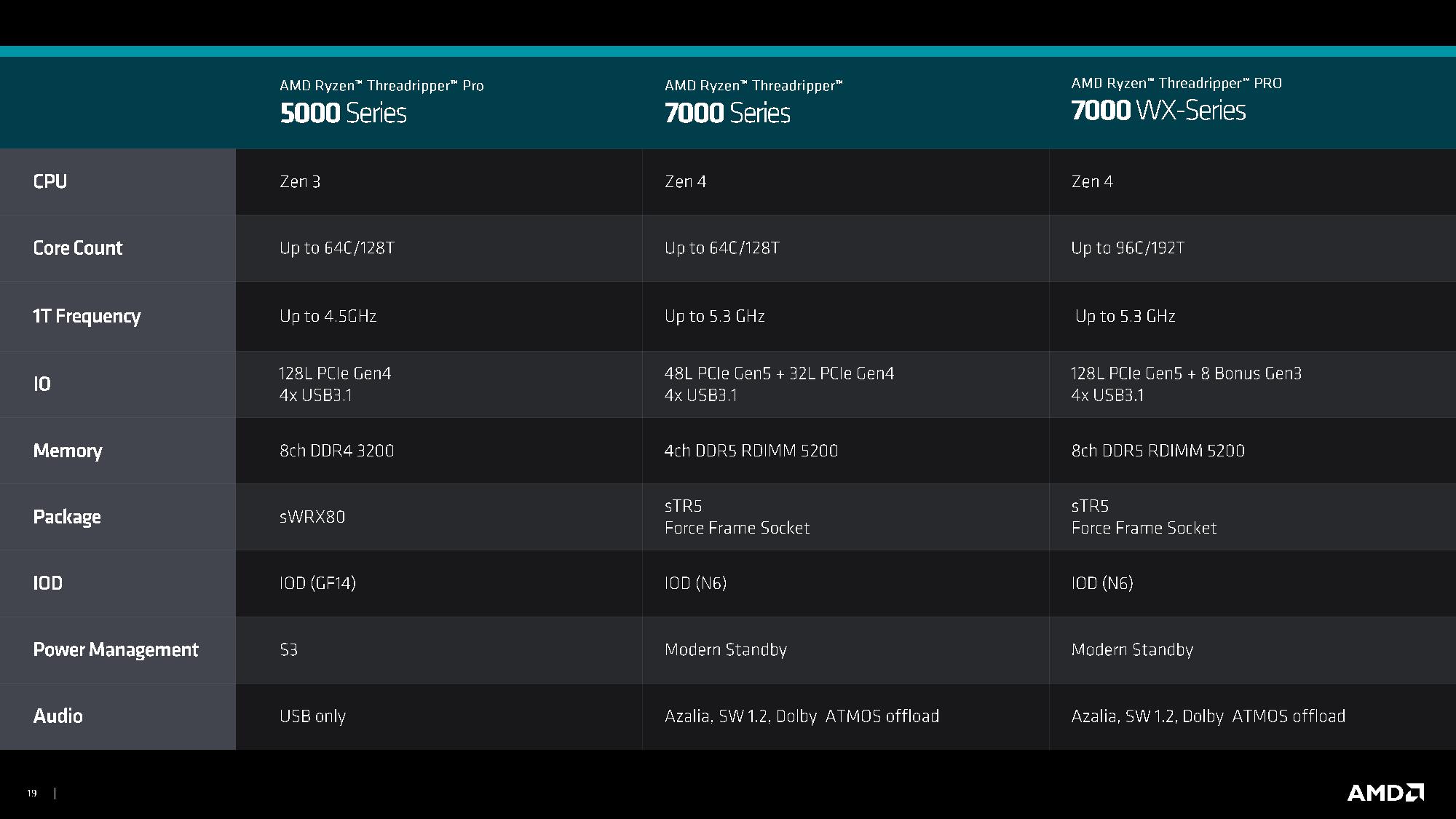
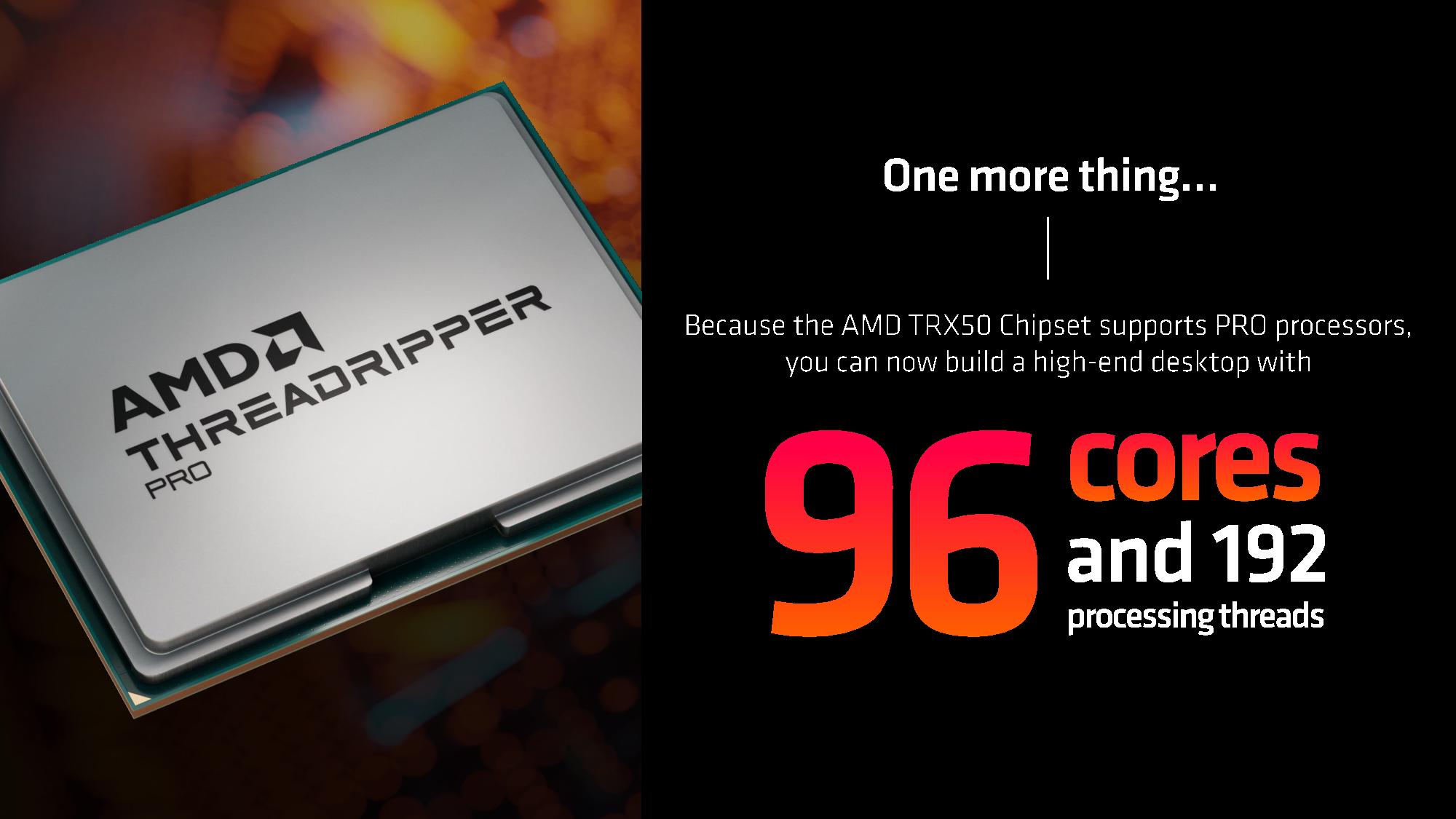
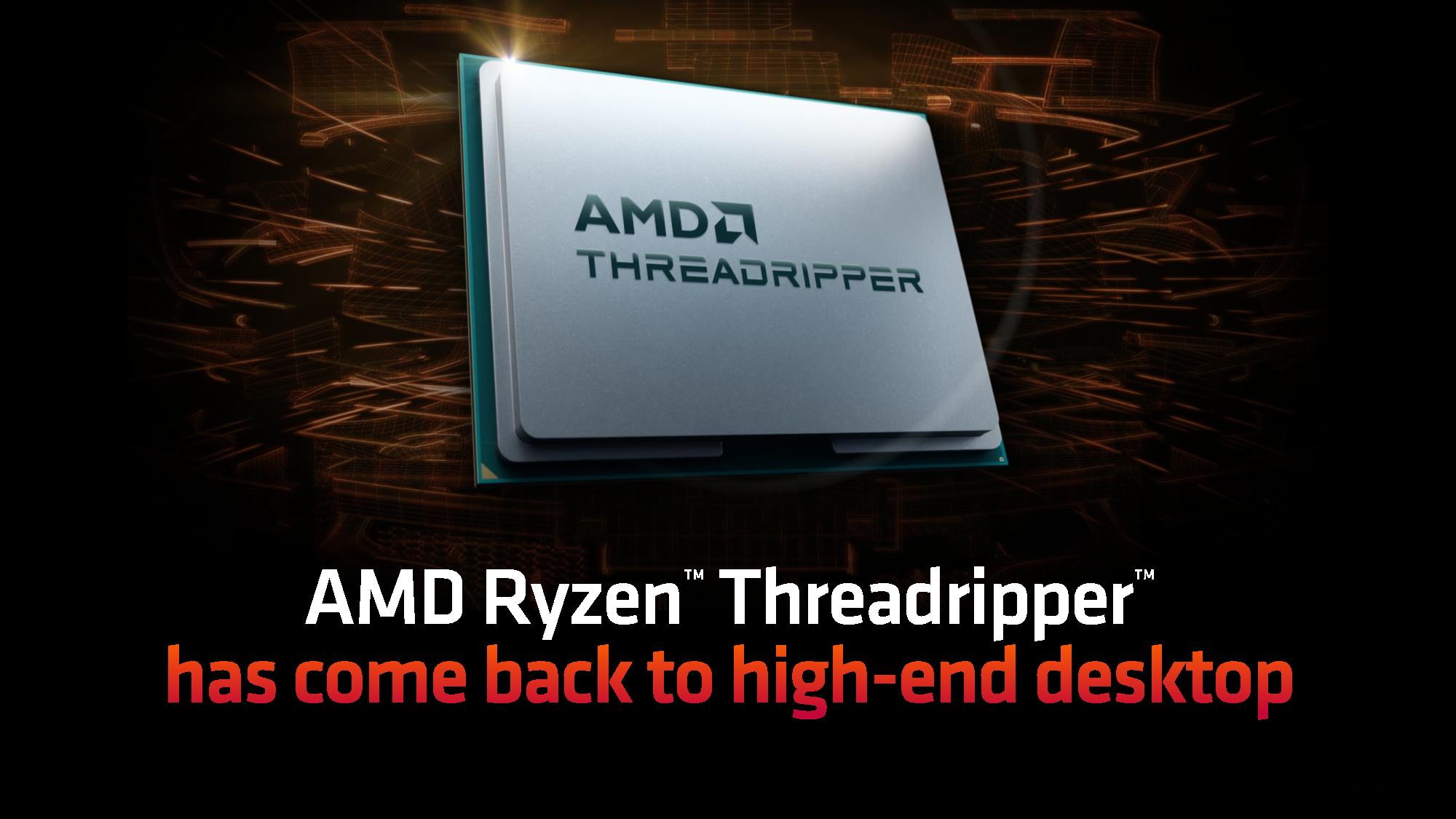
AMD shared performance data, but as always, you should take vendor-provided benchmarks with a grain of salt. That said, these benchmarks appear consistent with the benchmarks we've seen with our own eyes at AMD's event. AMD claims its 7980X is anywhere from 7% to 94% faster than Intel’s competing w9-3945X across a broad range of professional-class workloads. It also claims it’s 12% to 46% faster than the previous-gen Threadripper Pro 5995WX.
Get Tom's Hardware's best news and in-depth reviews, straight to your inbox.
| Row 0 - Cell 0 | MSRP/SEP | Cores / Threads | Base / Boost (GHz) | L3 Cache (MB) | TDP | PCIe | Memory |
| Threadripper 7980X | $4,999 | 64 / 128 | 3.2 / 5.1 | 256 MB | 350W | 48 (5.0) / 32 (4.0) | Four-Channel DDR5-5200 (RDIMM) |
| Intel w9-3495 | $5,889 | 56 / 112 | 1.9 / 4.8 | 105 | 350 / 420W | 112 | Eight-Channel DDR5-4800 (RDIMM) |
| Threadripper 3990X | $3,990 | 64 / 128 | 2.9 / 4.3 | 256 | 280W | 72 | Quad DDR4-3200 |
| Intel w9-3475X | $3,649 | 36 / 72 | 2.2 / 4.8 | 82.5 | 300 / 360W | 112 | Eight-Channel DDR5-4800 (RDIMM) |
| Threadripper 7970X | $2,499 | 32 / 64 | 4.0 / 5.3 | 128 MB | 350W | 48 (5.0) / 32 (4.0) | Four-Channel DDR5-5200 (RDIMM) |
| Threadripper 3970X | $1,999 | 32 / 64 | 3.7 / 4.5 | 128 | 280W | 64 | Quad DDR4-3200 |
| Threadripper 7960X | $1,499 | 24 / 48 | 4.2 / 5.3 | 128 MB | 350W | 48 (5.0) / 32 (4.0) | Four-Channel DDR5-5200 (RDIMM) |
| Intel w7-3455 | $2,600 | 24 / 48 | 2.5 / 4.8 | 67.5 | 270 / 324W | 112 | Eight-Channel DDR5-4800 (RDIMM) |
| Threadripper 3960X | $1,399 | 24 / 48 | 3.8 / 4.5 | 128 | 280W | 64 | Quad DDR4-3200 |
| Ryzen 9 7950X | $699 | 16 / 32 | 4.5 / 5.7 | 64 MB | 170W / 230W | 24 | Dual DDR5-5200 |
The new Threadripper 7000-series for HEDT all come with a 350W TDP and support four channels of DDR5-5200 memory (the Pro series supports 8 channels). The TRX50 platform also has only 48 PCIe 5.0 lanes compared to the Pro series’ support for 128 PCIe 5.0 lanes, but AMD threw in 32 additional PCIe 4.0 lanes. AMD cut back on the number of memory channels to help reduce the size of the system and the cost of populating the memory channels, whereas using fewer PCIe 5.0 lanes also allows the use of fewer pricey retimers, thus also reducing cost.
AMD’s Pro and HEDT platforms both require DDR5 ECC (RDIMM) memory, which is expensive. Unlike prior generations of memory, DDR5 has a different type of slot for standard (UDIMM) and ECC (RDIMM) memory — you can’t have both on the same motherboard — and AMD opted for the latter. AMD is working with its memory partners to bring overclockable RDIMMs to market (presumably EXPO), much as Intel supports overclockable RDIMMs with its competing Xeon W chips. The standard Threadripper platform supports 1DPC and up to 1TB of DDR5-5200 memory, though AMD says capacity is simply limited by the size of today’s RDIMMs.
The Threadripper 7000-series starts at $1,399 for the 24-core 48-thread Threadripper 3960X, and peak boost clocks have increased by 600 MHz over the prior-gen 3960X, now reaching 5.3 GHz. The $1,399 price tag might give you sticker shock, but Intel’s competing 24-core w7-3455 weighs in at $2,600. The $2,499 32-core Threadripper 7970X slots in with a peak boost clock of 5.3 GHz and is also significantly less expensive than Intel’s competing processor.
Finally, the flagship $4,999 Threadripper 7980X wields an incredible 64 cores, 128 threads, and 256 MB of L3 cache. Once again, even though this chip is pricey, it's $1,000 less than Intel’s competing 56-core chip.
AMD offers 12- and 16-core models for the Pro workstation segment, but didn't release those lower core count models for the standard HEDT lineup because that segment is served by its standard Ryzen processors.
If you’re dead set on creating the most monstrous HEDT system imaginable, the Threadripper TRX50 socket for HEDT will accommodate that desire with support for the 96-core Threadripper Pro 7995WX. However, this specialized processor is truly designed for the utmost performance in heavily threaded applications like rendering, and TRX50's support for only four channels of DDR5 memory could significantly hamper performance in some of those extreme workloads. For that, it's better to step up to the eight-channel workstation platform.
Ryzen Threadripper Pro 7000 WX-Series Specifications
| Row 0 - Cell 0 | MSRP/SEP | Cores / Threads | Base / Boost (GHz) | L3 Cache (MB) | TDP | PCIe | Memory |
| Threadripper Pro 7995WX | TBD | 96 / 192 | 2.5 / 5.1 | 384 MB | 350W | 128 (5.0) / 8 (4.0) | Eight-Channel DDR5-5200 (RDIMM) |
| Threadripper Pro 7985WX | TBD | 64 / 128 | 3.2 / 5.1 | 256 MB | 350W | 128 (5.0) / 8 (4.0) | Eight-Channel DDR5-5200 (RDIMM) |
| Intel w9-3495 | $5,889 | 56 / 112 | 1.9 / 4.8 | 105 | 350 / 420W | 112 | Eight-Channel DDR5-4800 (RDIMM) |
| Threadripper Pro 5995WX | $6,499 | 64 / 128 | 2.7 / 4.5 | 256 | 280W | 128 | Eight-Channel DDR4-3200 |
| Intel w9-3475X | $3,649 | 36 / 72 | 2.2 / 4.8 | 82.5 | 300 / 360W | 112 | Eight-Channel DDR5-4800 (RDIMM) |
| Threadripper Pro 7975WX | TBD | 32 / 64 | 3.2 / 5.3 | 128 MB | 350W | 128 (5.0) / 8 (4.0) | Eight-Channel DDR5-5200 (RDIMM) |
| Threadripper Pro 5975WX | $3,299 | 32 / 64 | 3.6 / 4.5 | 128 | 280W | 128 | Eight-Channel DDR4-3200 |
| Threadripper Pro 7965WX | TBD | 24 / 48 | 4.2 / 5.3 | 128 MB | 350W | 128 (5.0) / 8 (4.0) | Eight-Channel DDR5-5200 (RDIMM) |
| Intel w7-3455 | Row 9 - Cell 1 | 24 / 48 | 2.5 / 4.8 | 67.5 | 270 / 324W | 112 | Eight-Channel DDR5-4800 (RDIMM) |
| Threadripper Pro 5965WX | $2,399 | 24 / 48 | 3.8 / 4.5 | 128 | 280W | 128 | Eight-Channel DDR4-3200 |
The previous-gen Threadripper Pro series topped out at 64 cores, but the Ryzen Threadripper Pro 7000 WX-Series adds a new behemoth at the top of the stack, the 96-core 192-thread Threadripper Pro 7995WX. This processor features an incredible 384 MB of L3 cache, a 2.5 GHz base, and a 5.1 GHz boost frequency, while the smaller models can reach peak frequencies of up to 5.3 GHz. This chip easily outweighs Intel’s Sapphire Rapids-based 56-core 112-thread w9-3945X in every facet.
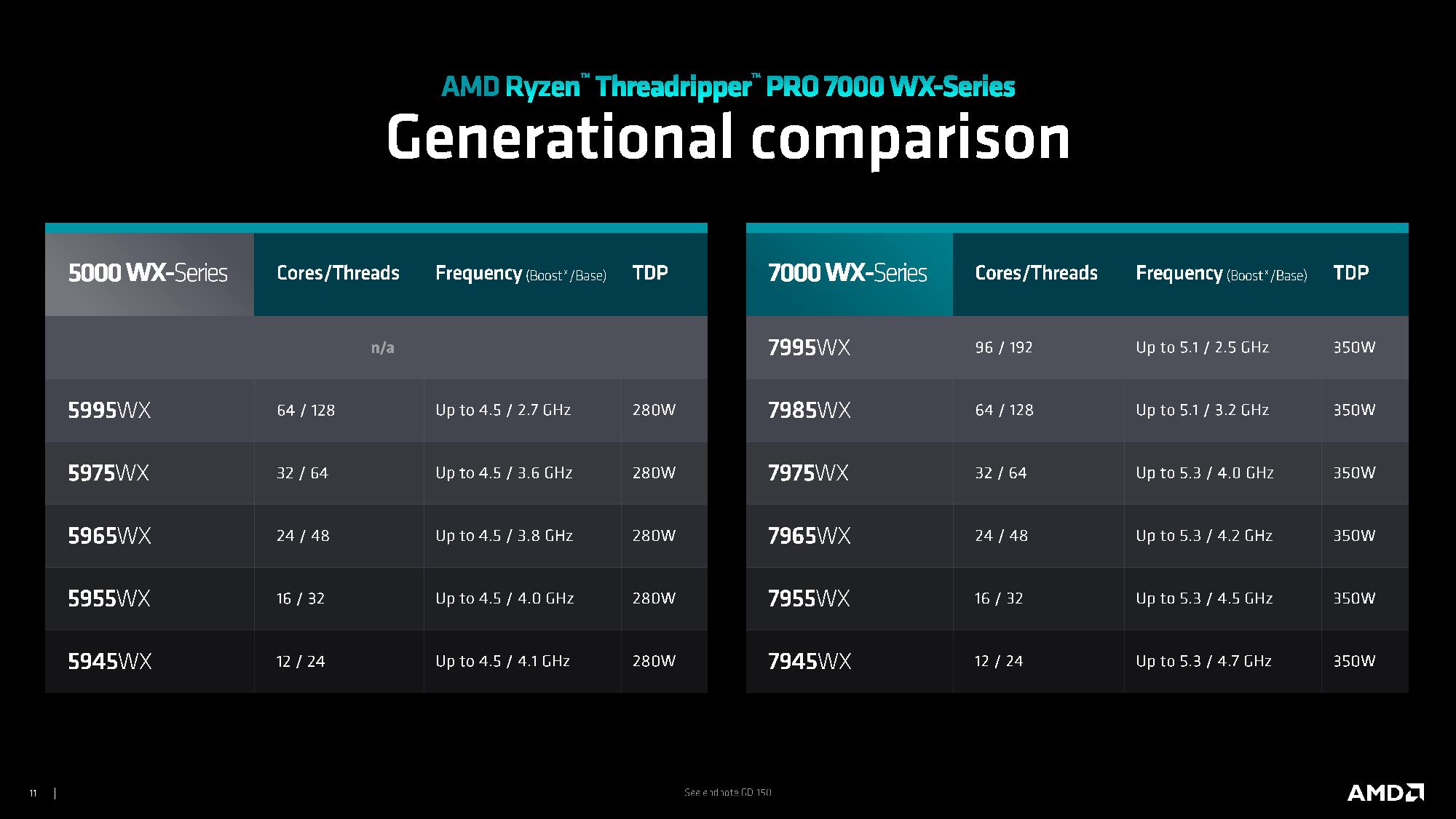
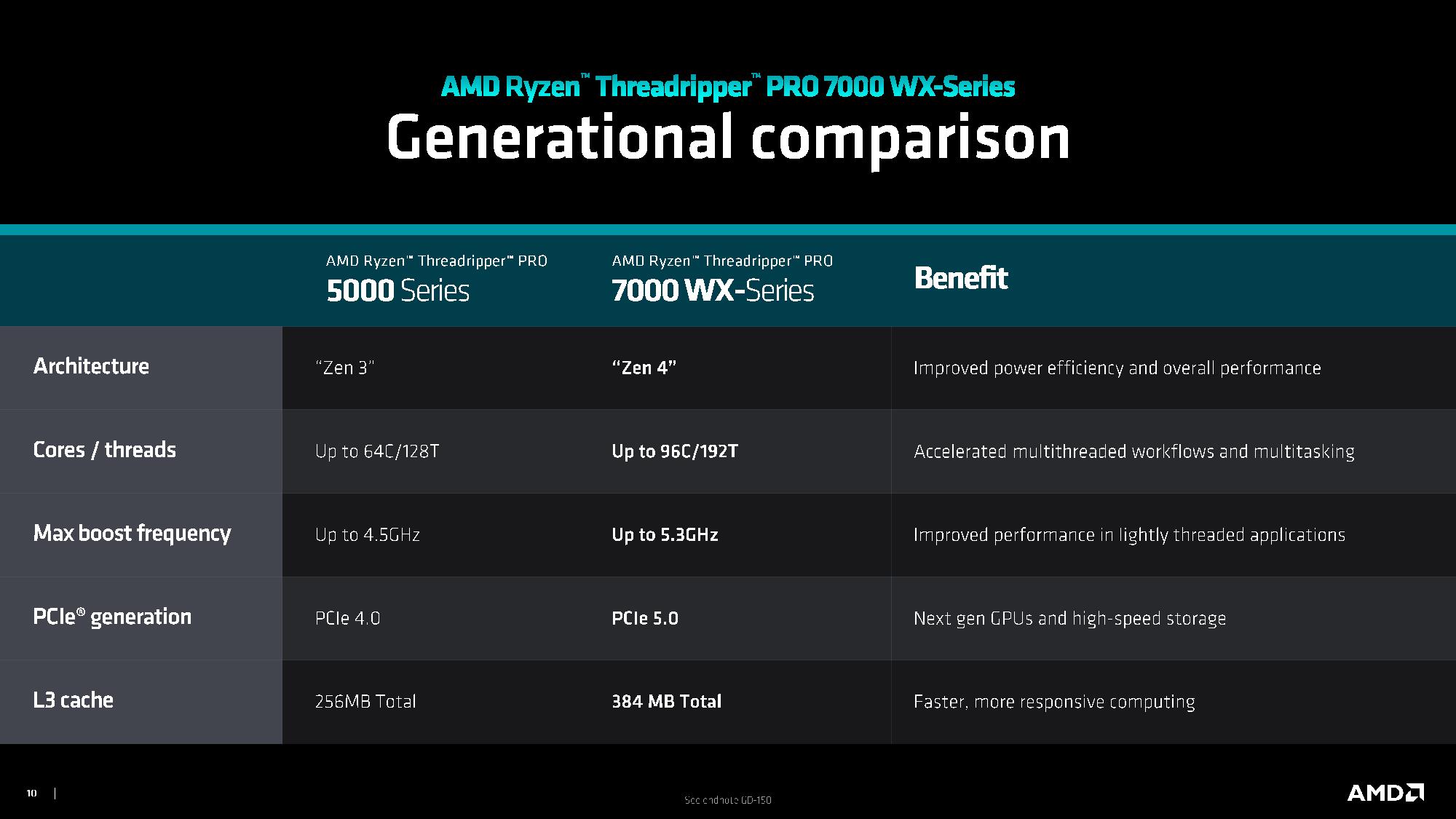
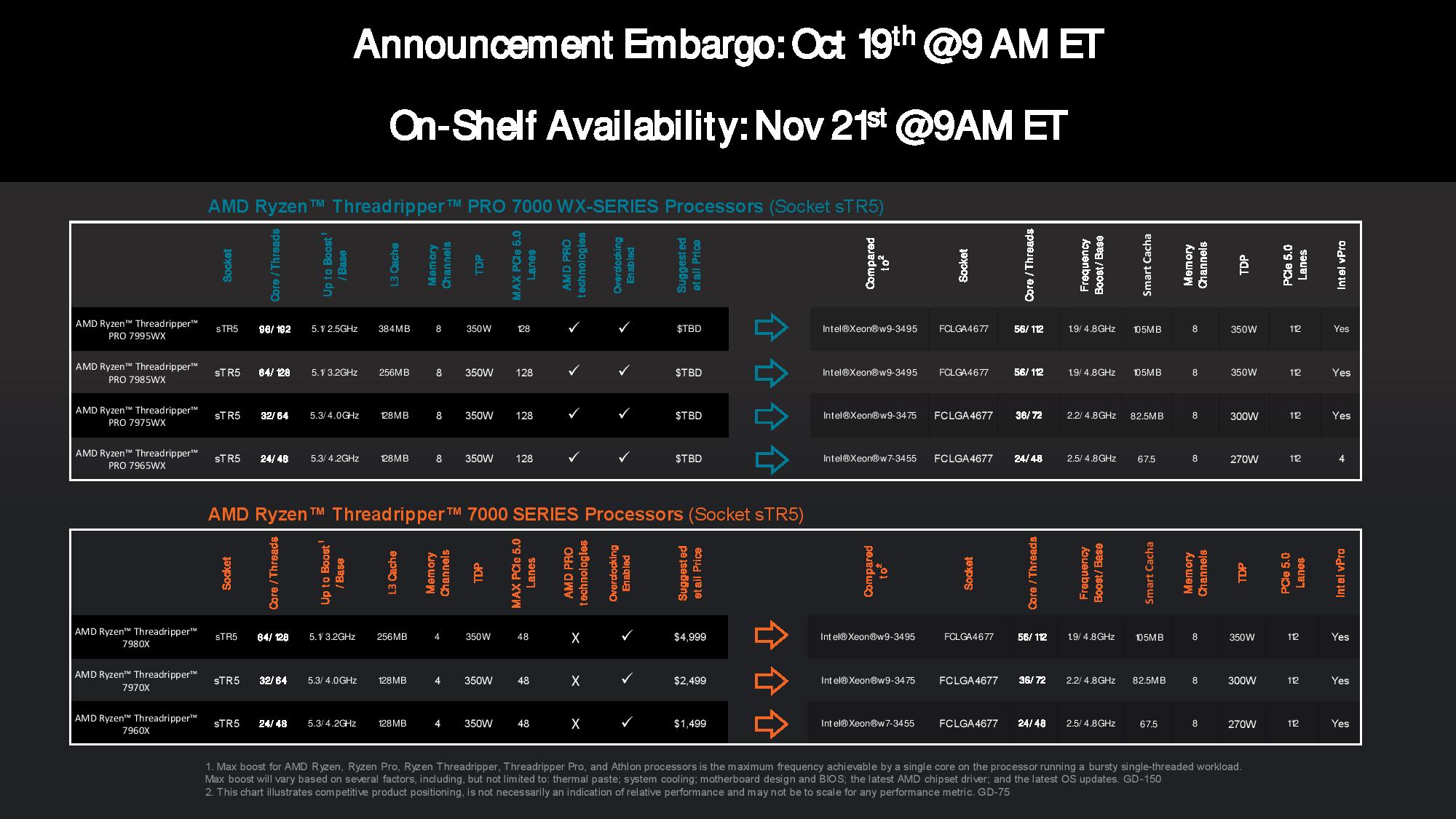
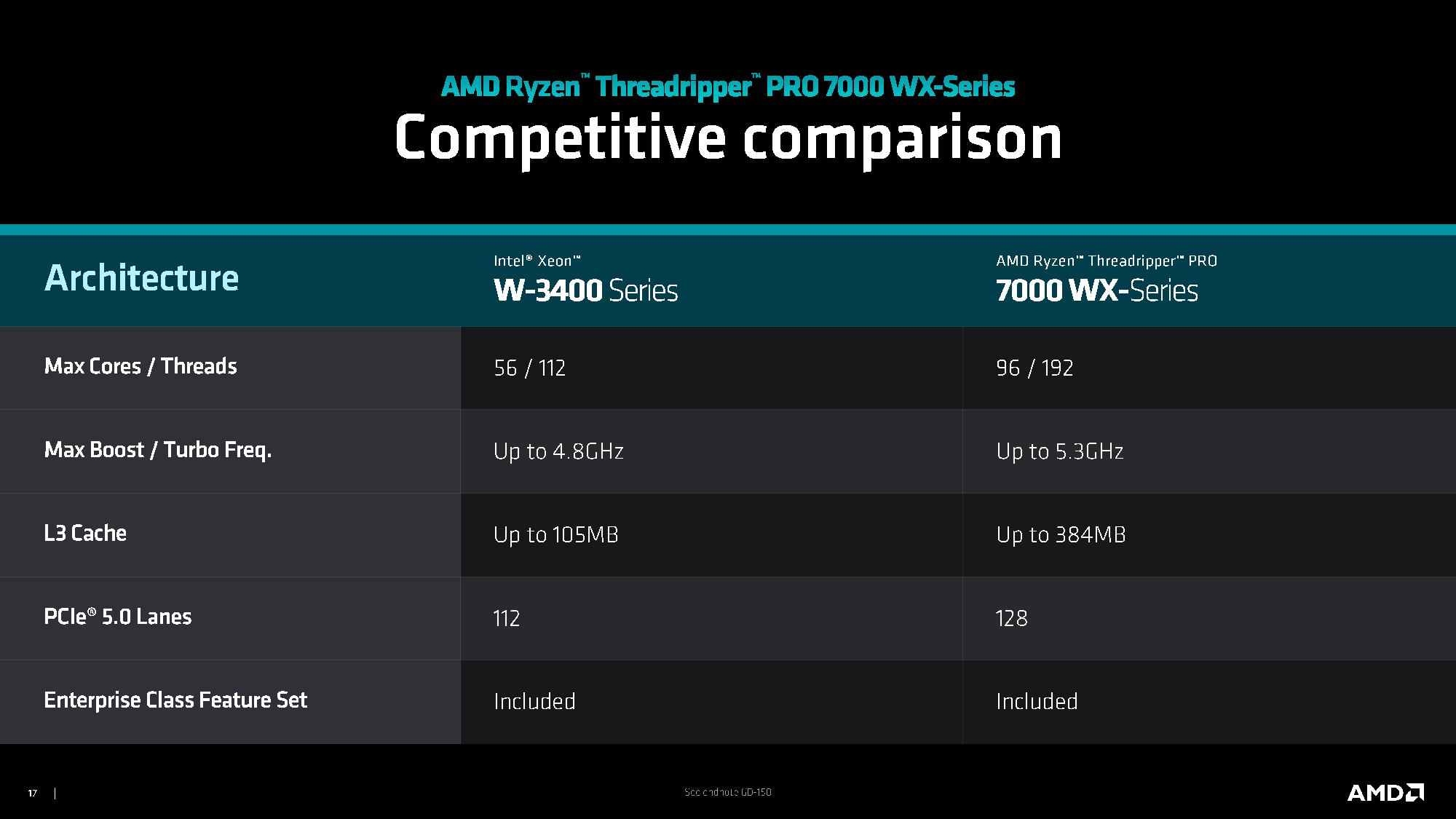
Beneath the flagship, AMD also has six other WX-series processors available that match the core counts of the 5000 WX-series, including the comparatively modest 12-core 24-thread 7945WX and the 16-core 32-thread 7955WX. These models may seem a bit out of place given that AMD’s mainstream desktop CPUs now stretch up to 16 cores, but these are designed for users that prize the additional memory throughput from 8-channel DDR5-5200 memory (1DPC, 2TB peak capacity for the Pro series) and the connectivity advantage of up to 128 lanes of PCIe 5.0 and 8 lanes of PCIe 4.0.
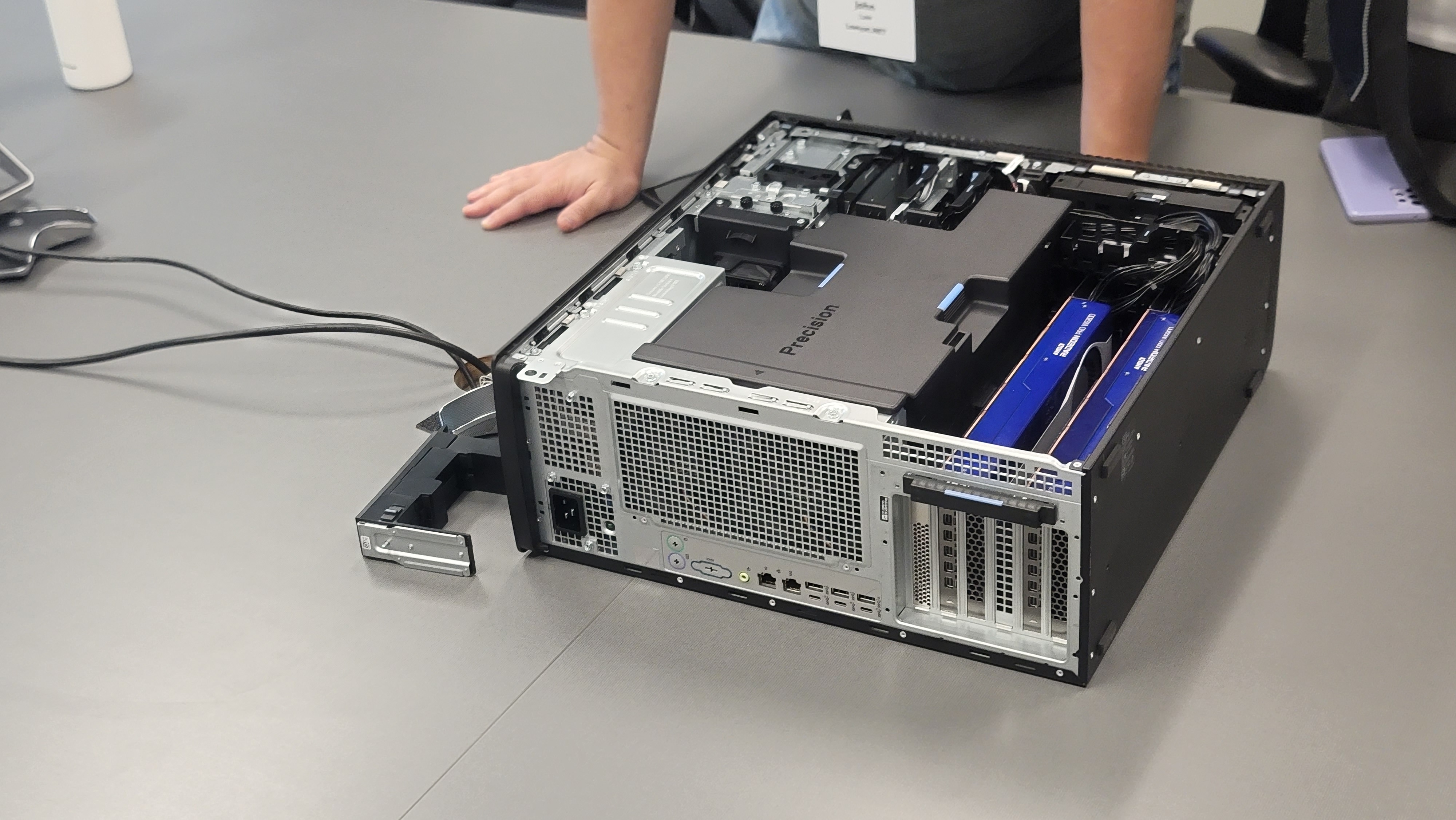
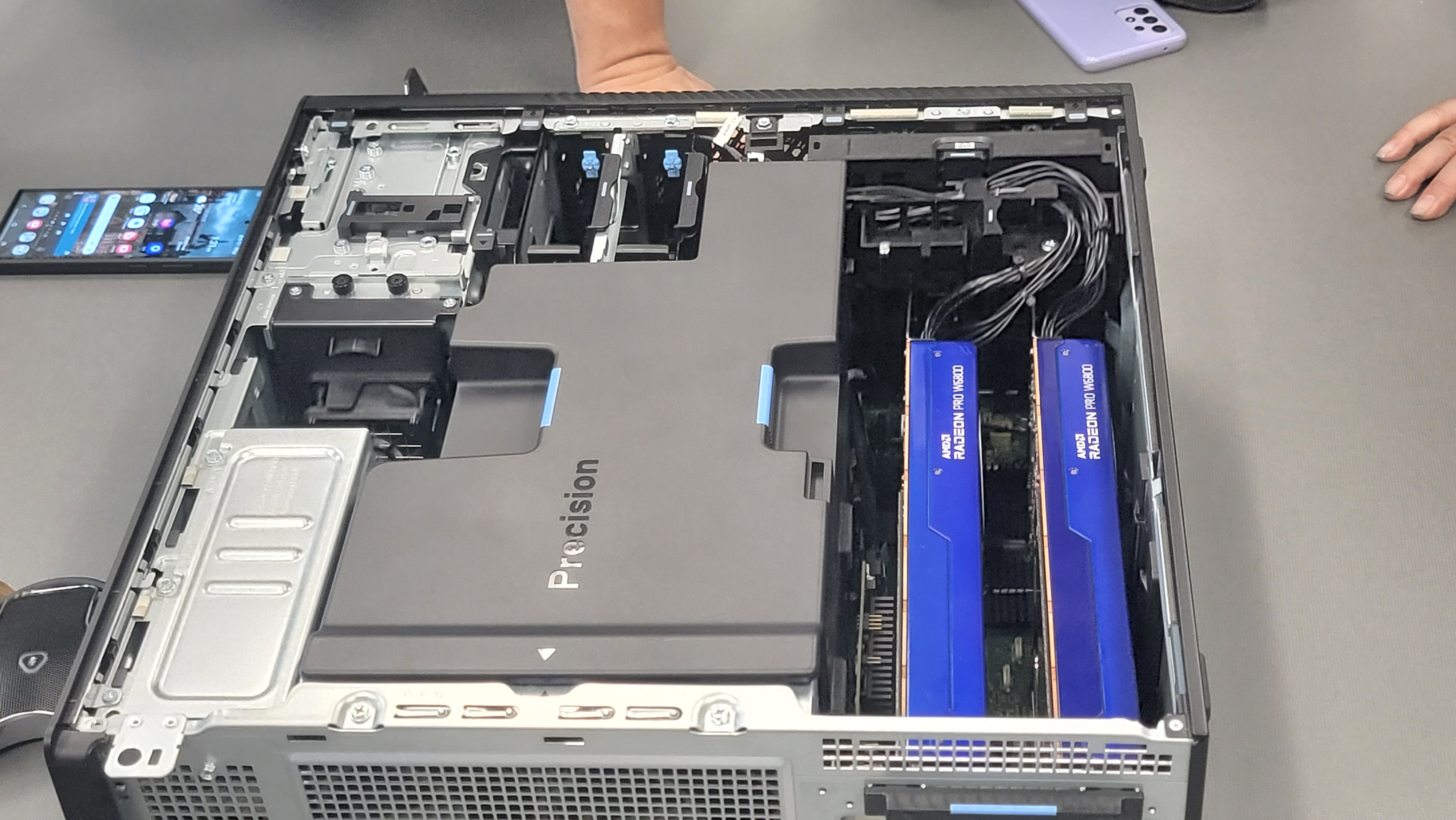
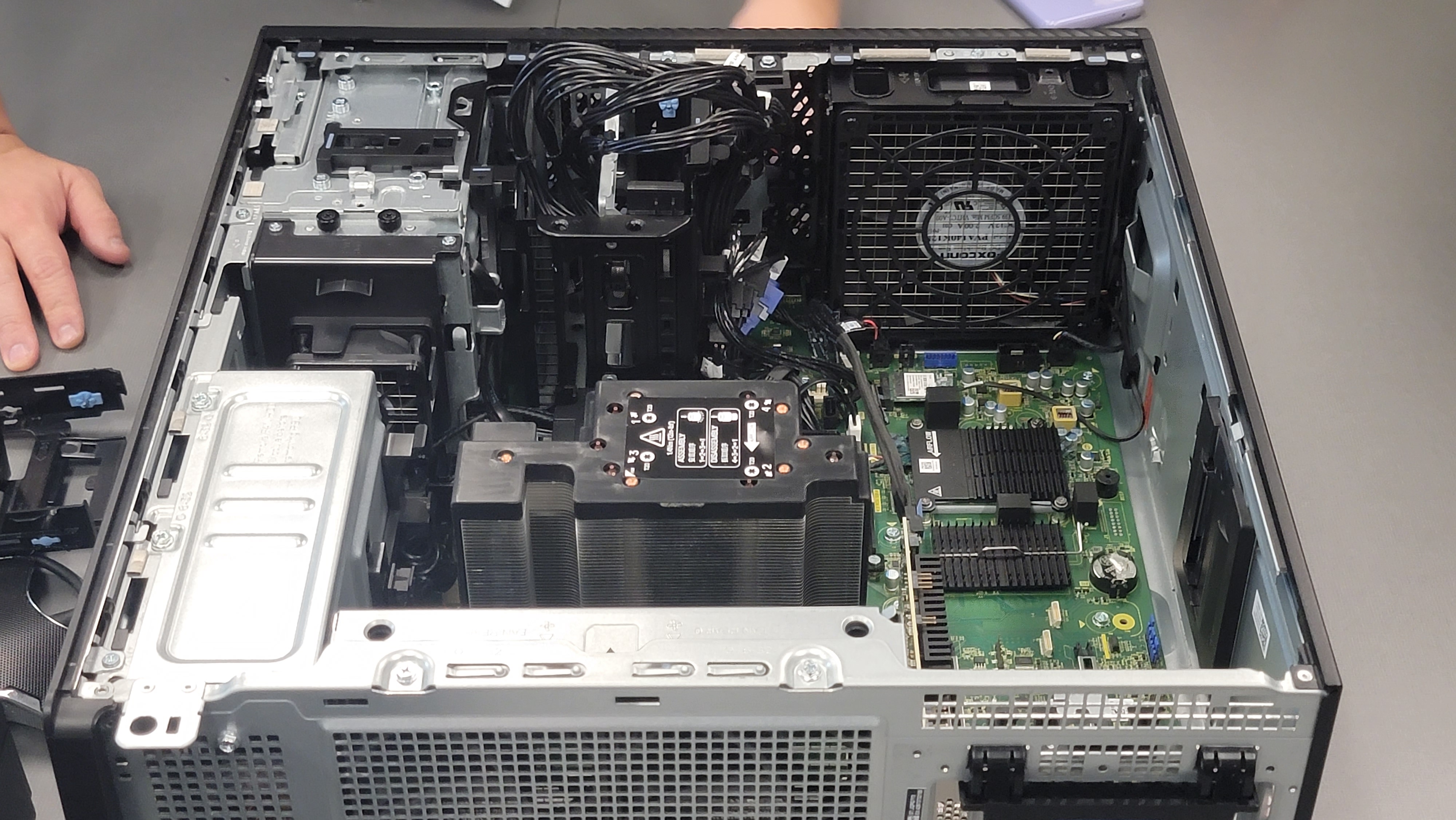
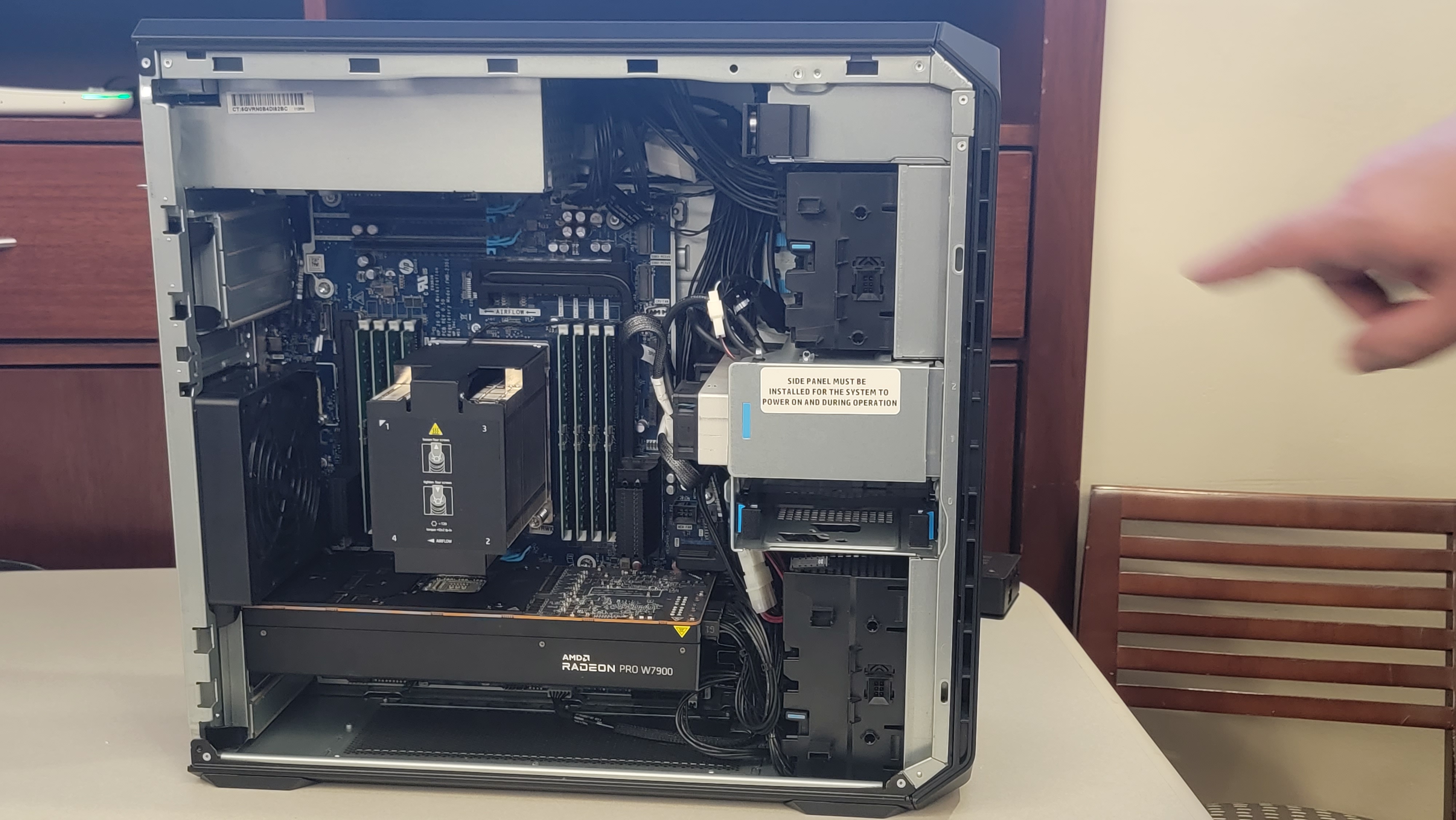
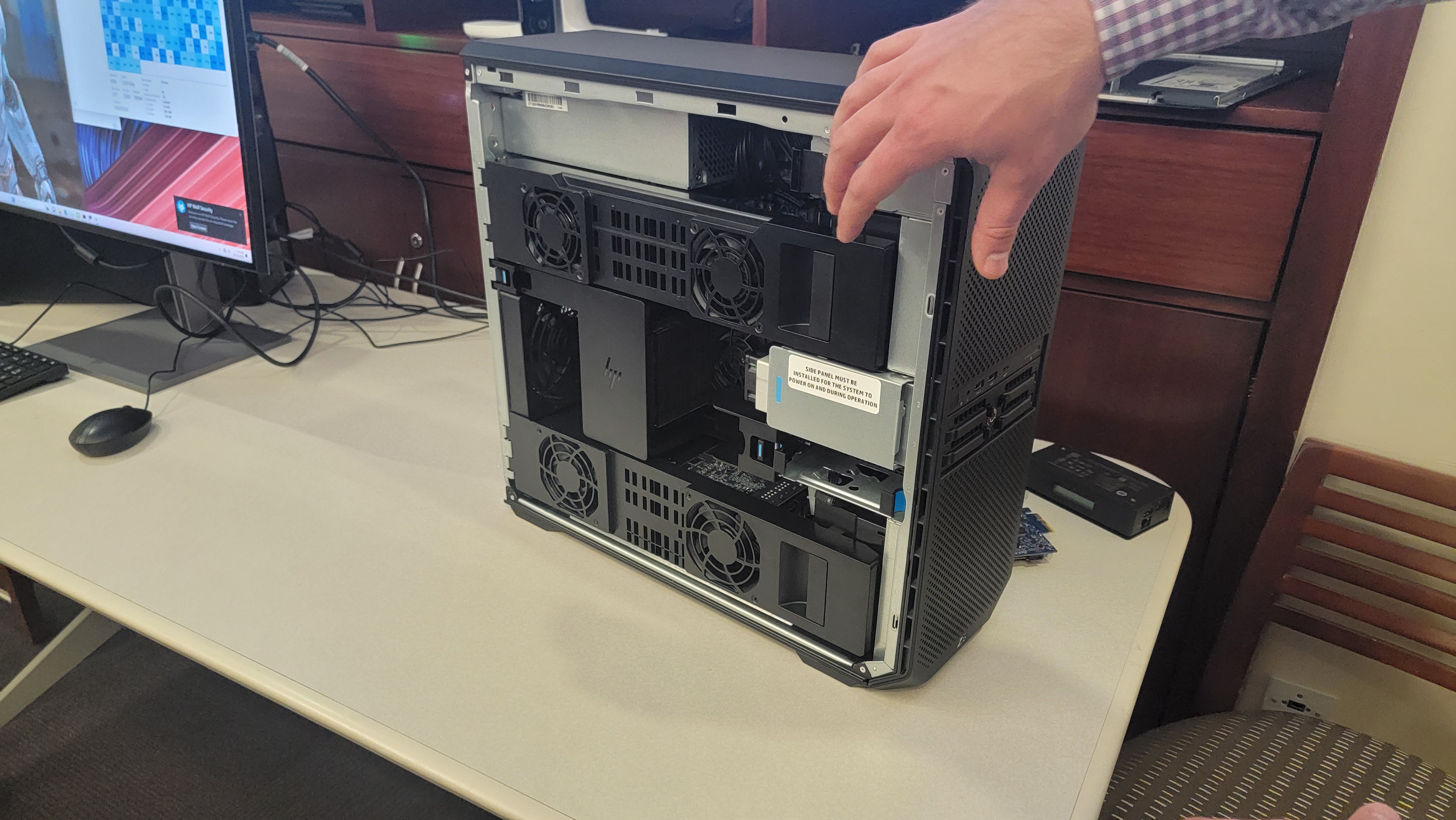
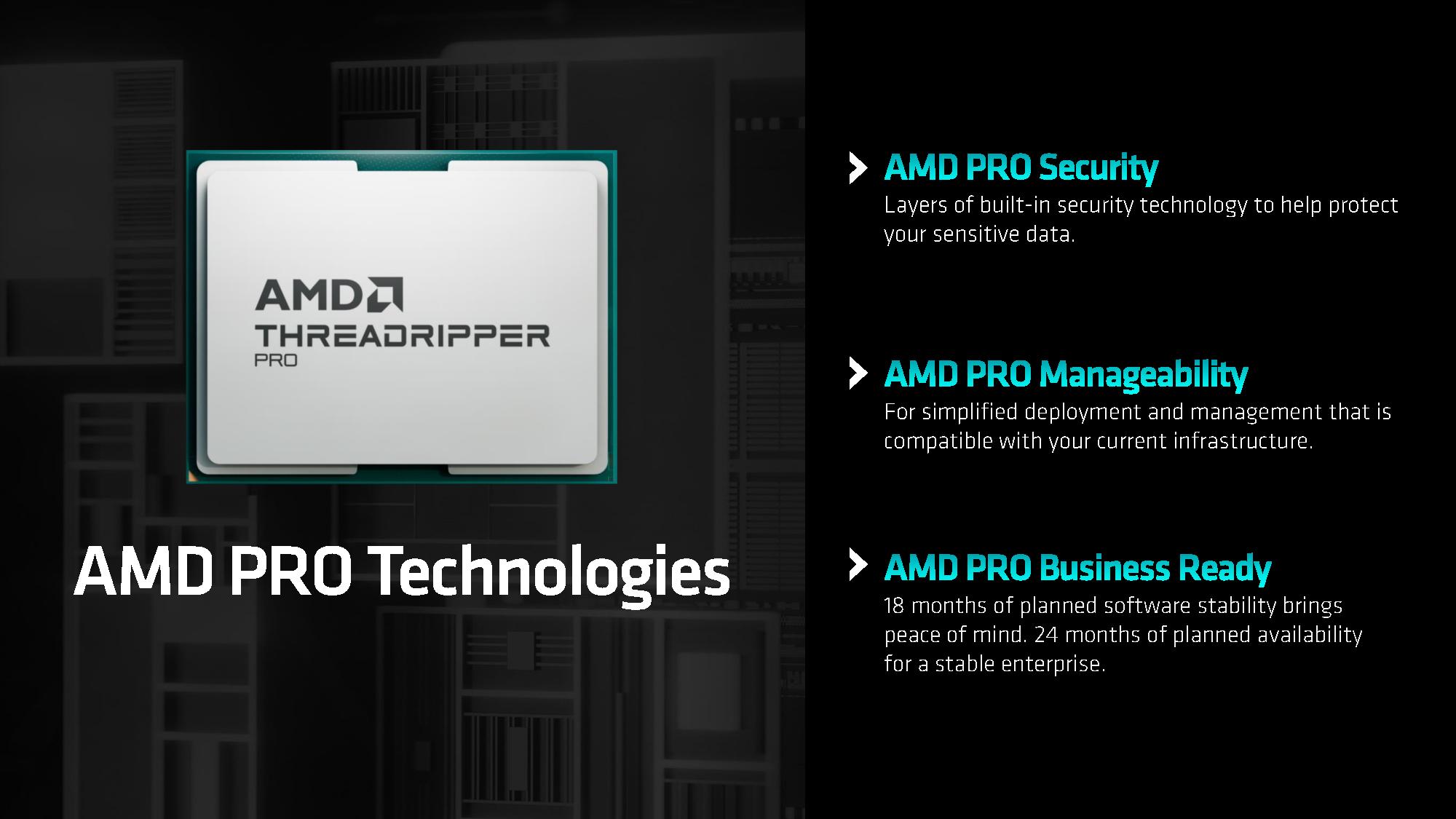
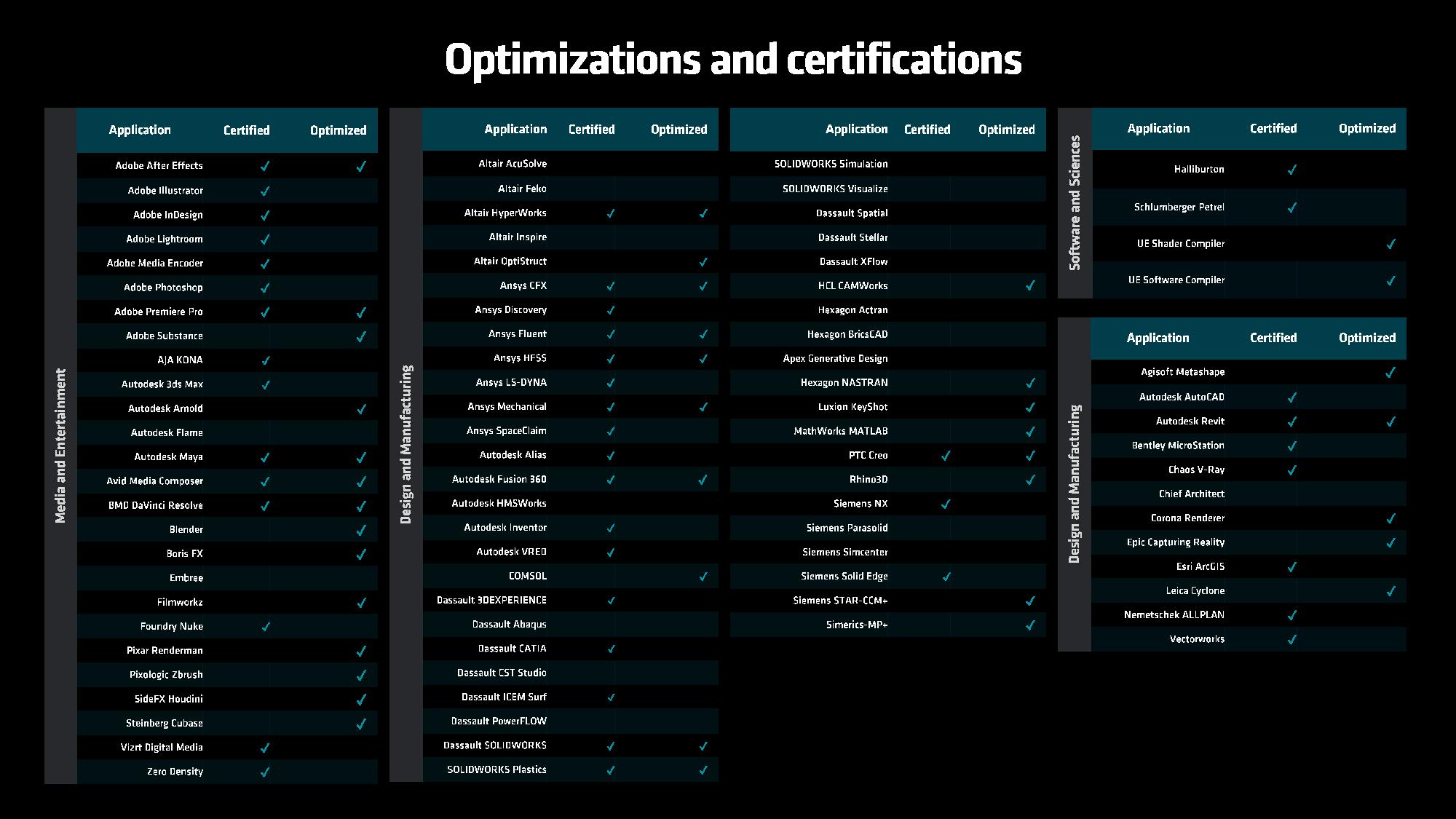
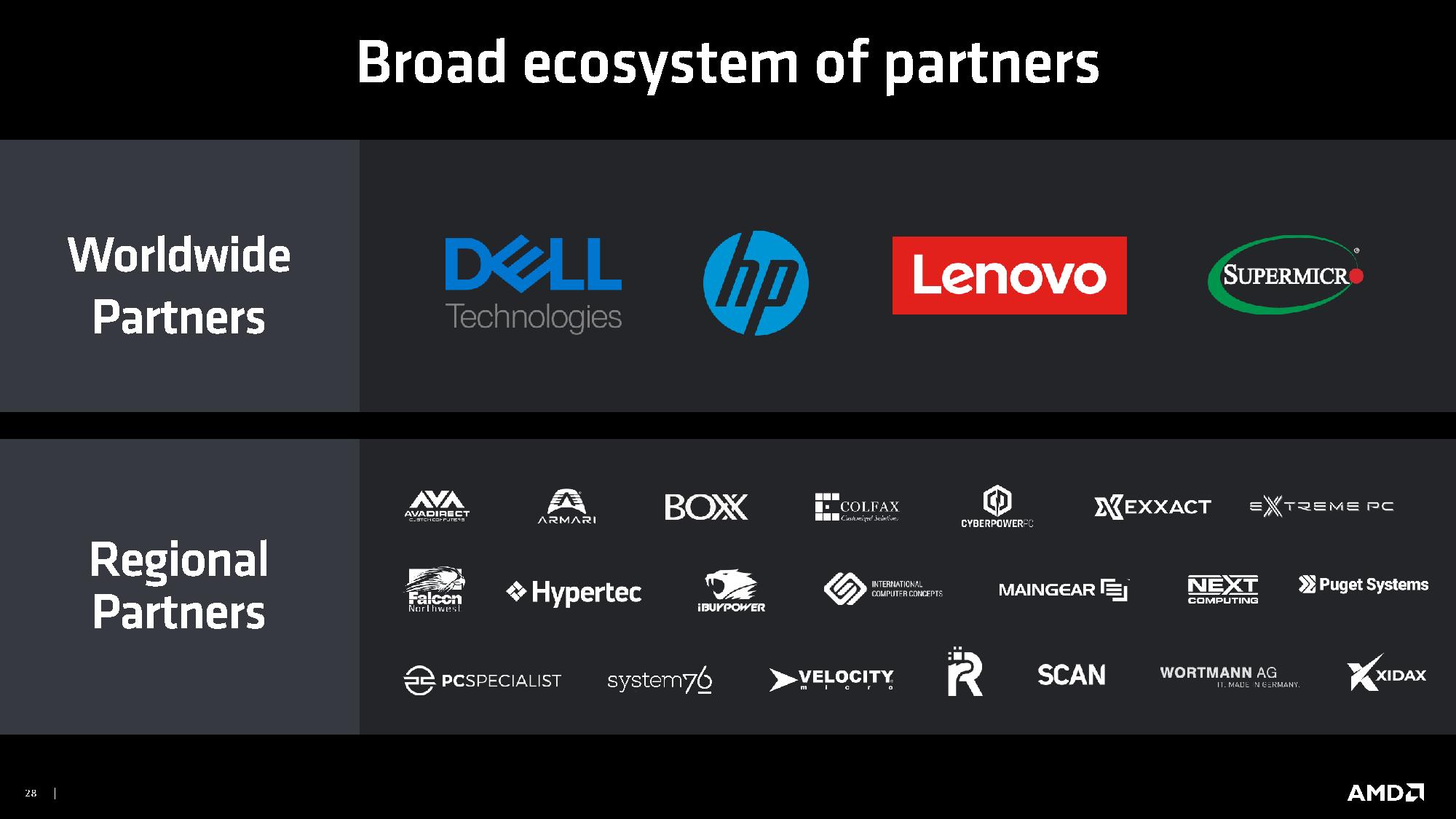
AMD has worked with both global and regional OEMs to bring a wide range of systems to market, some of which you can see in the above album. These include systems from Dell Technologies and HP, but Lenovo will share details of its systems at a later date. As expected, the Pro series supports AMD’s full Pro Manageability suite, with features like AMD Secure Processor, Shadow Stack, and Memory Guard.
Ryzen Threadripper Pro 7000 WX-Series Performance
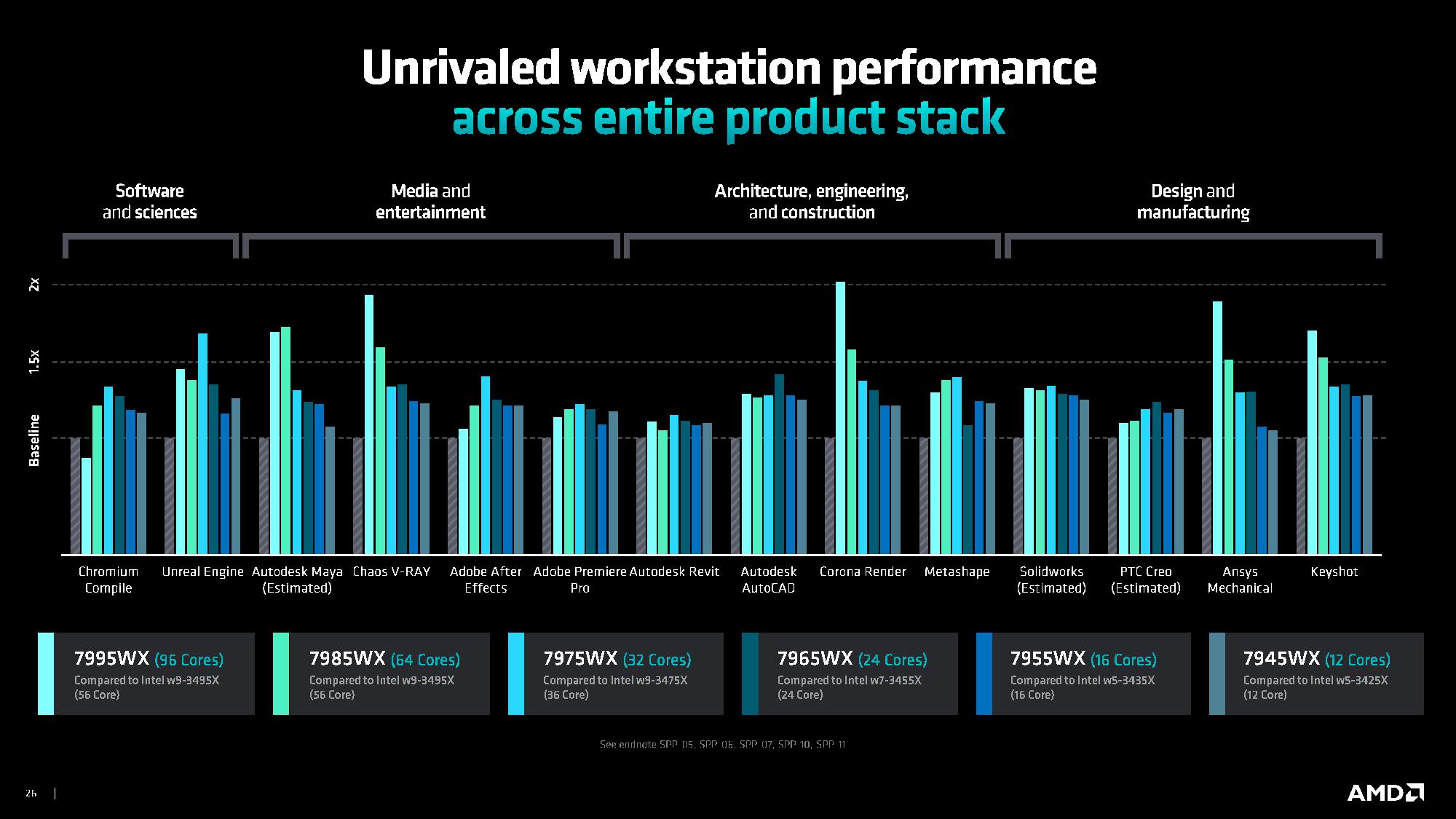
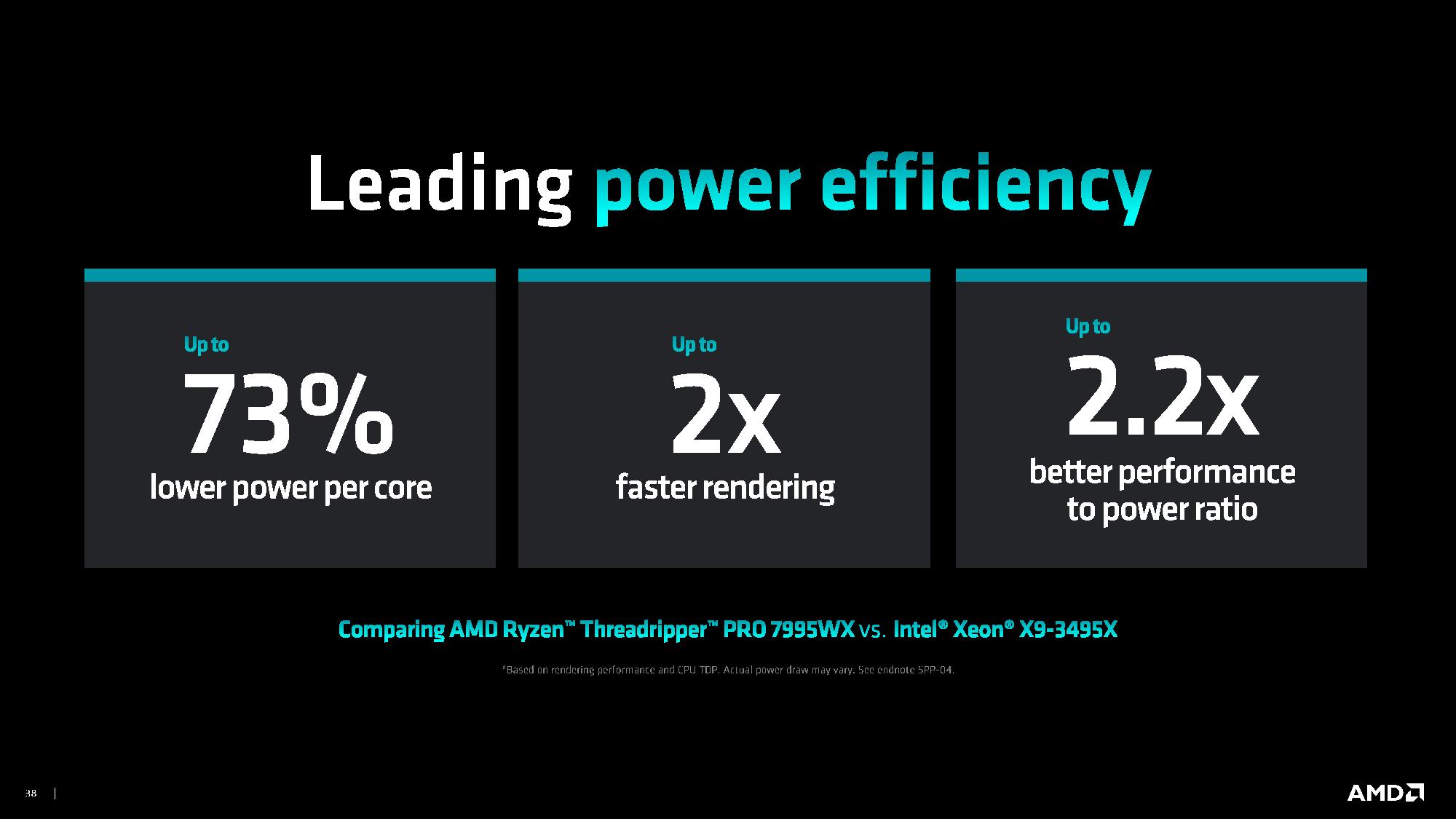
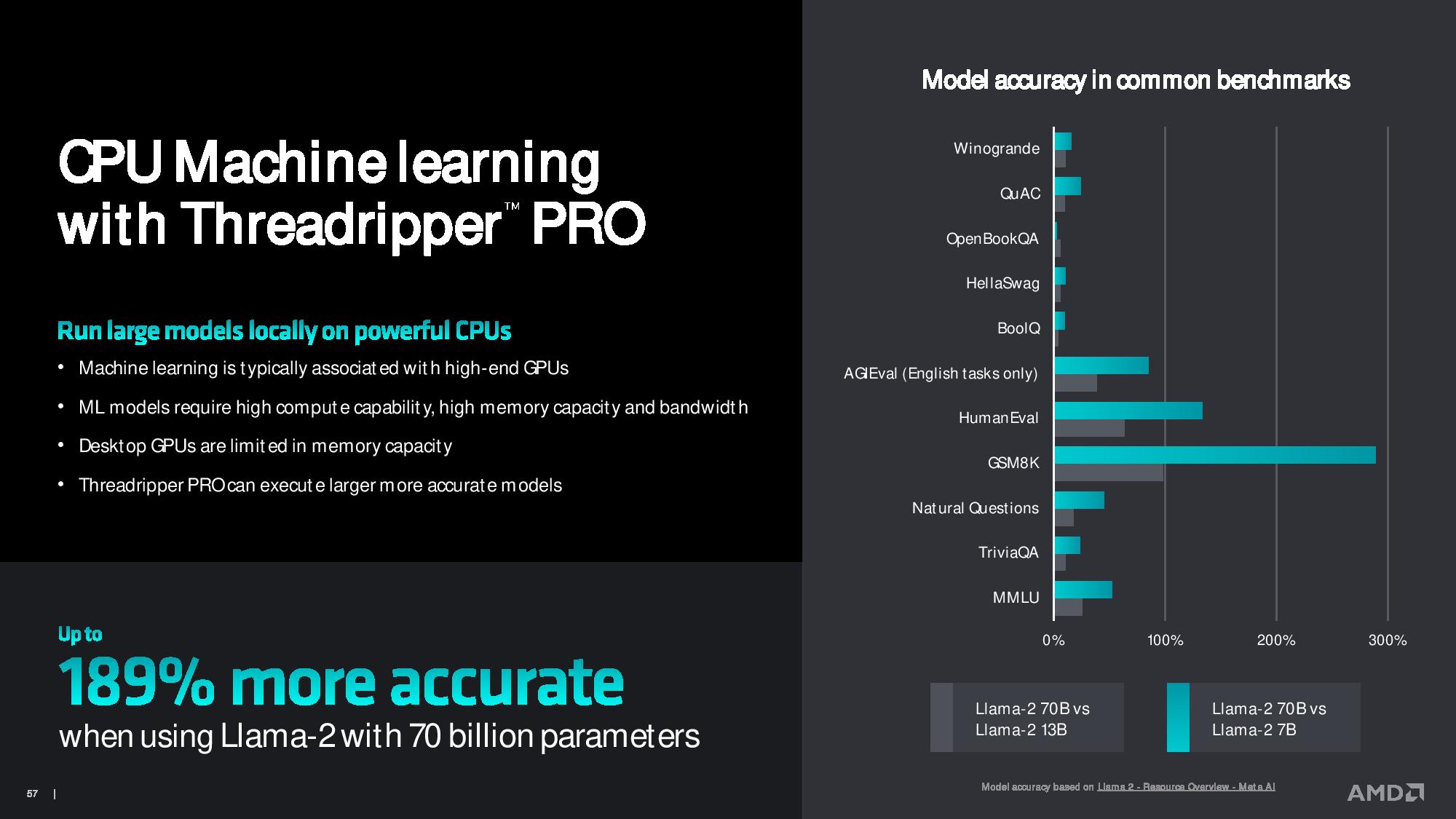
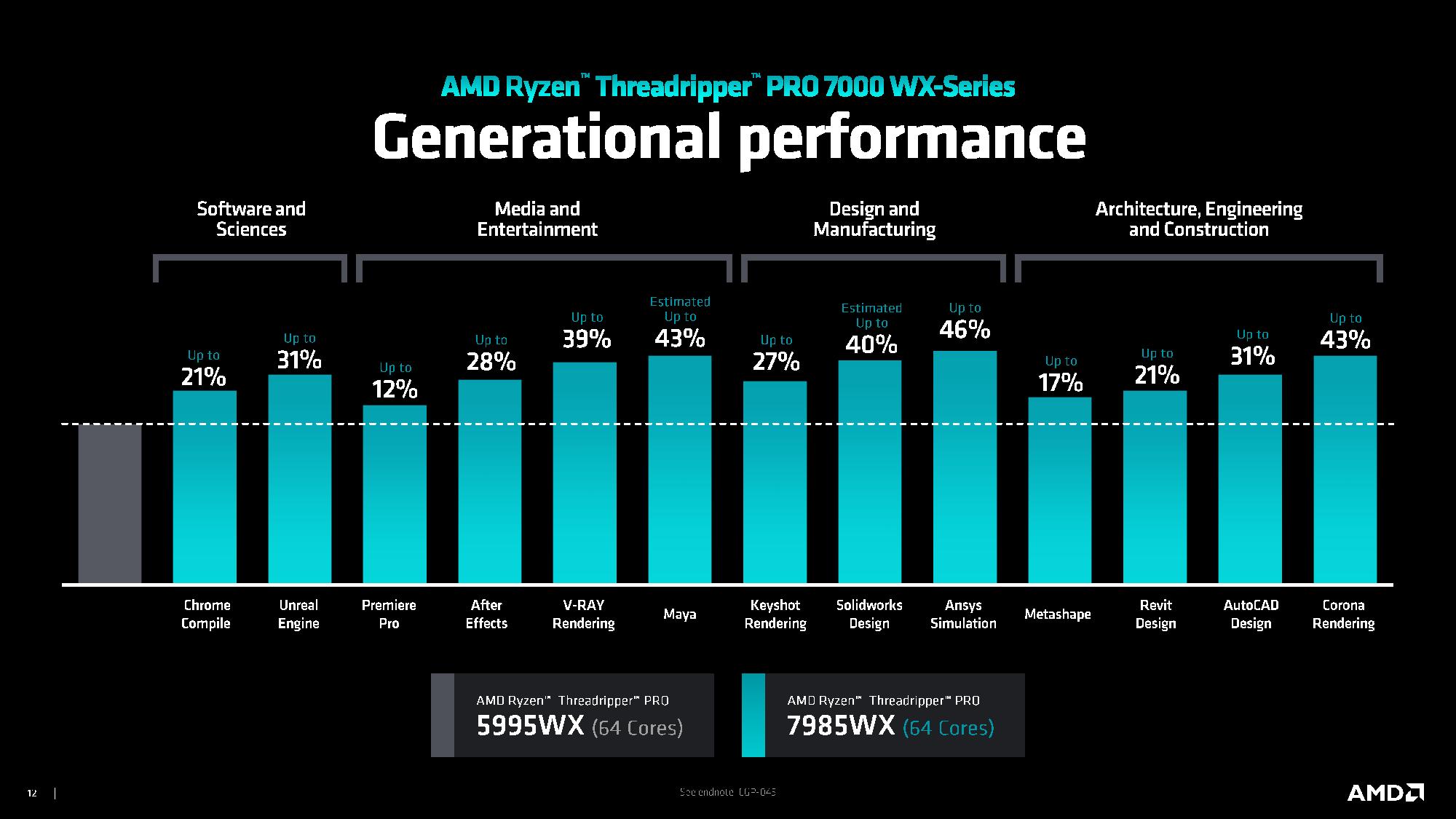
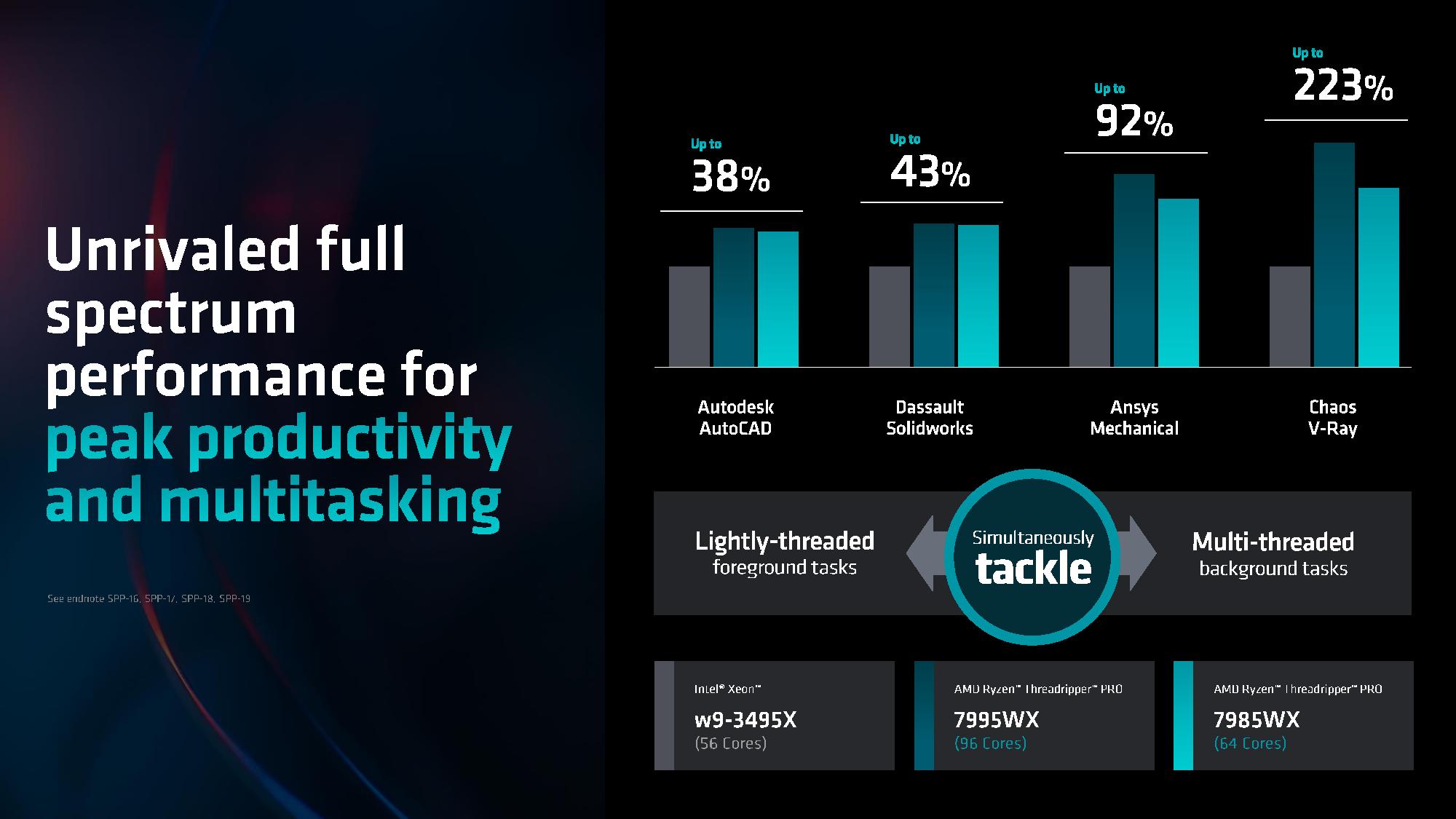
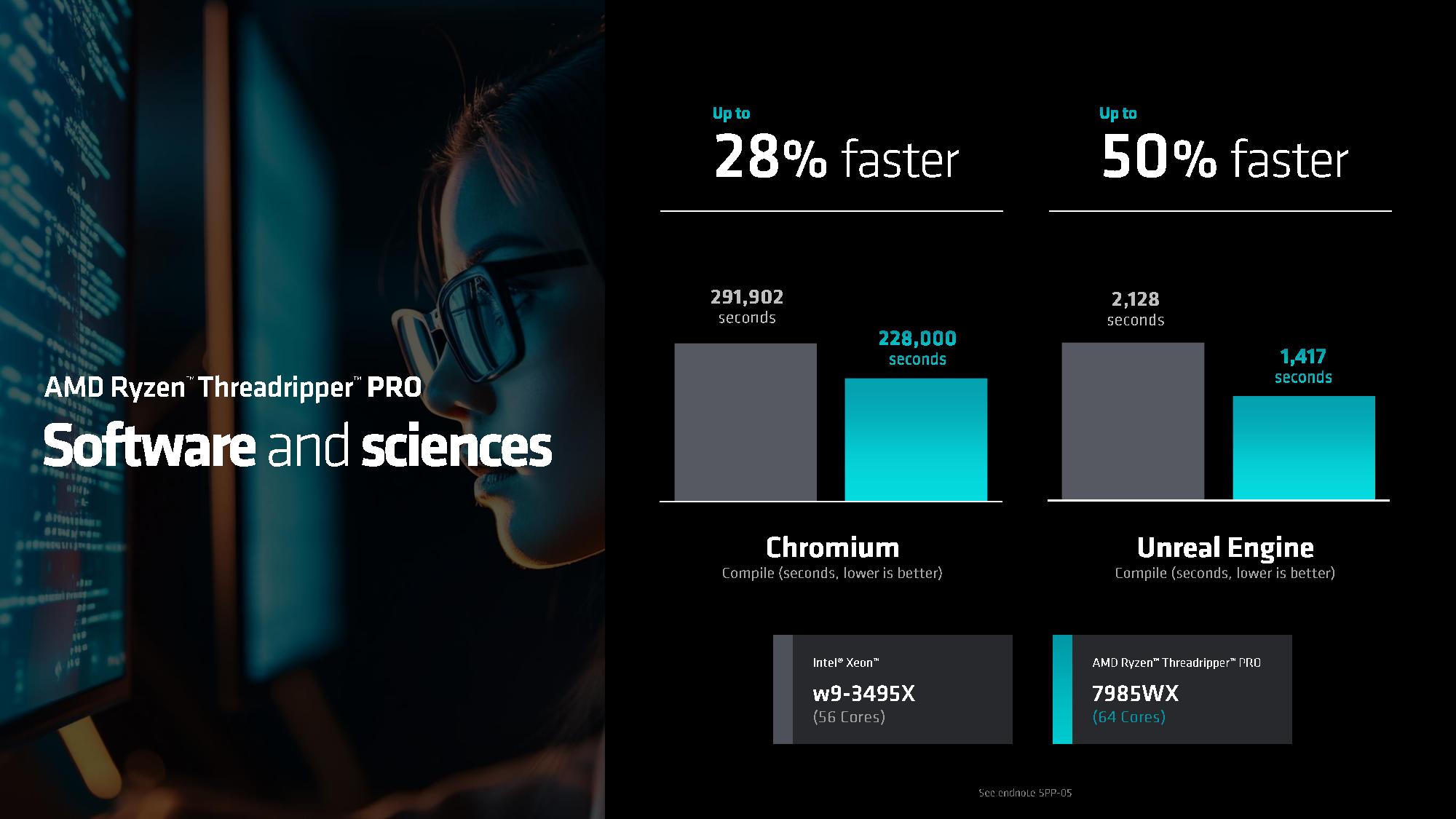
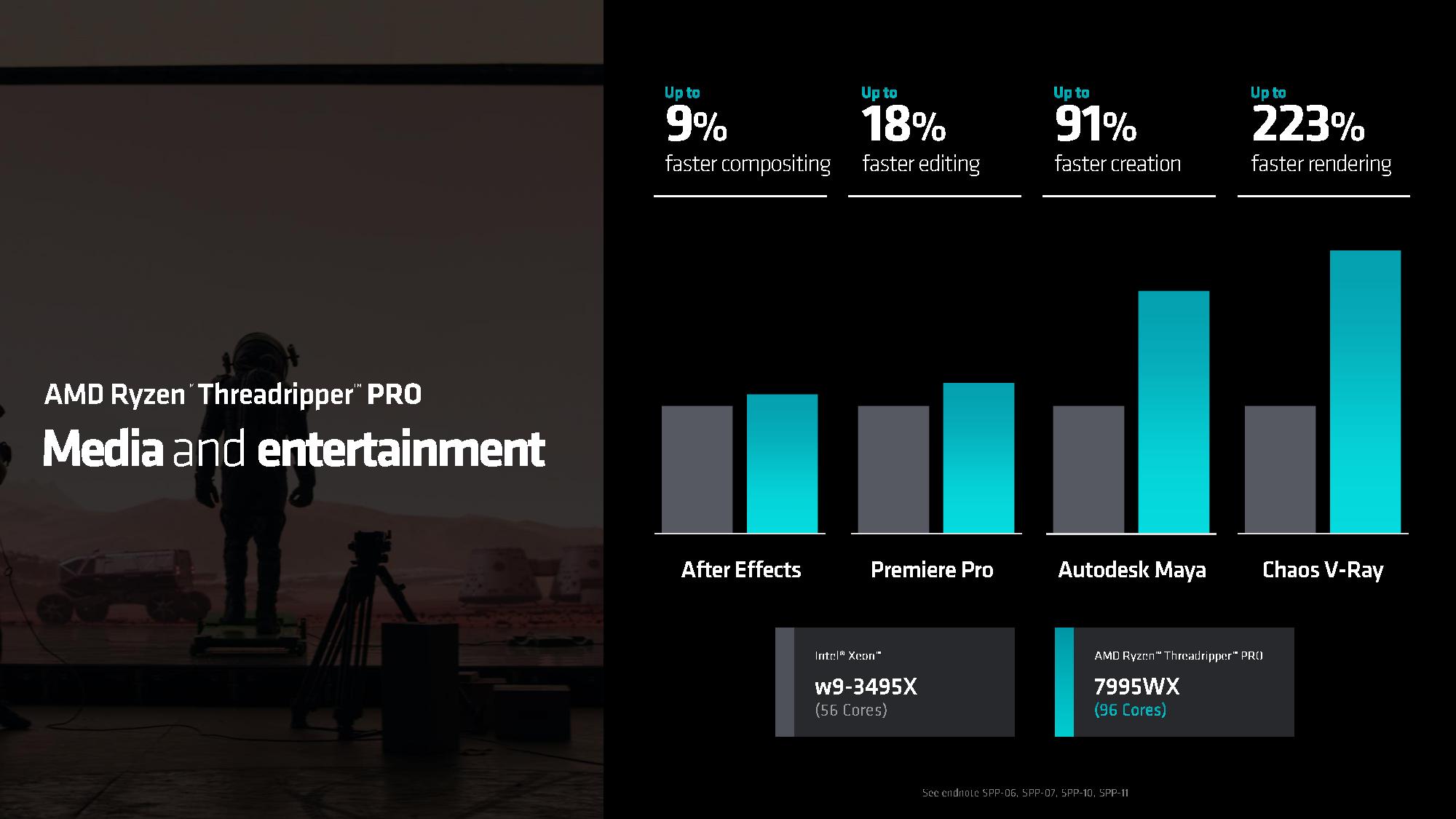
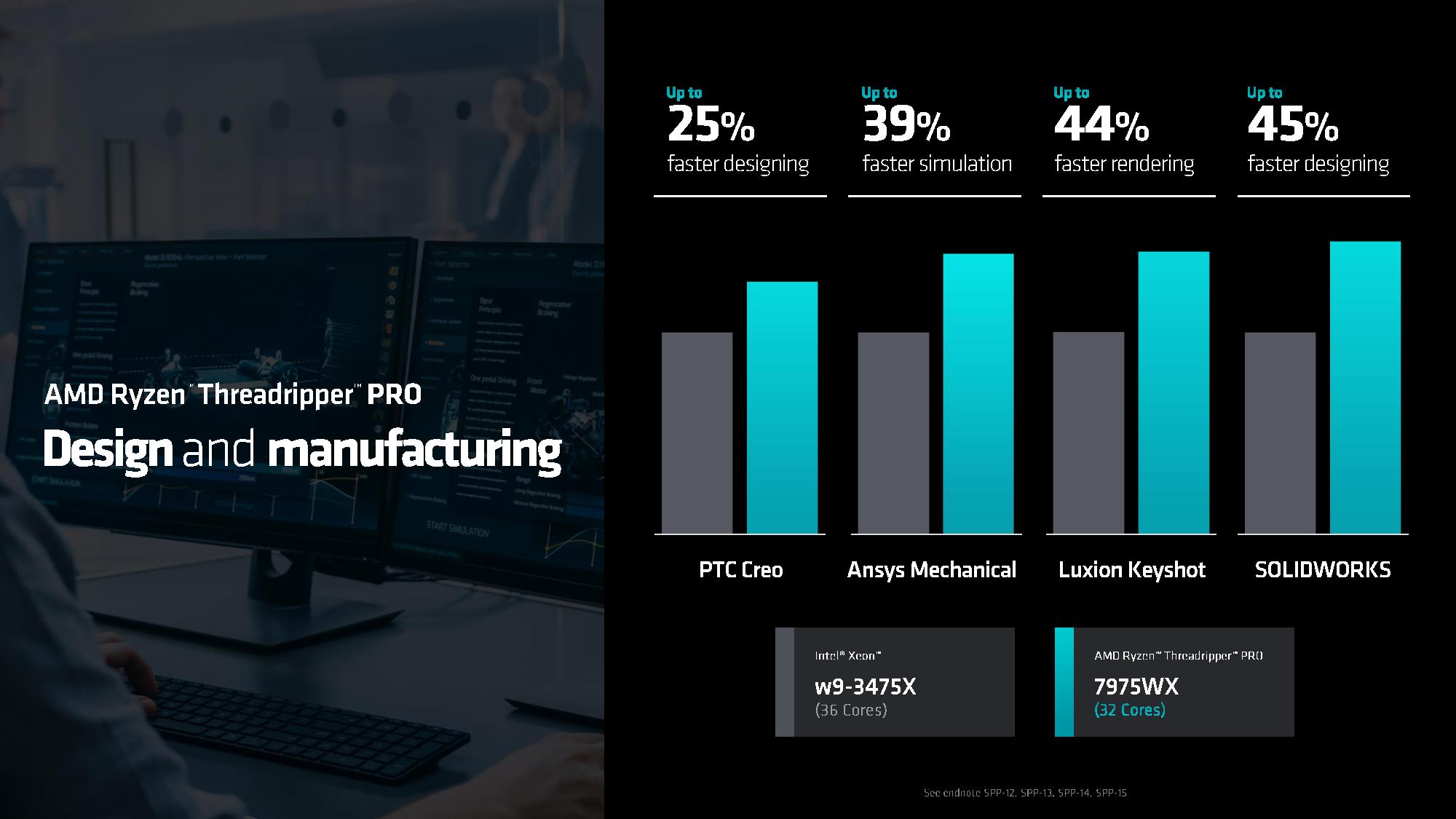
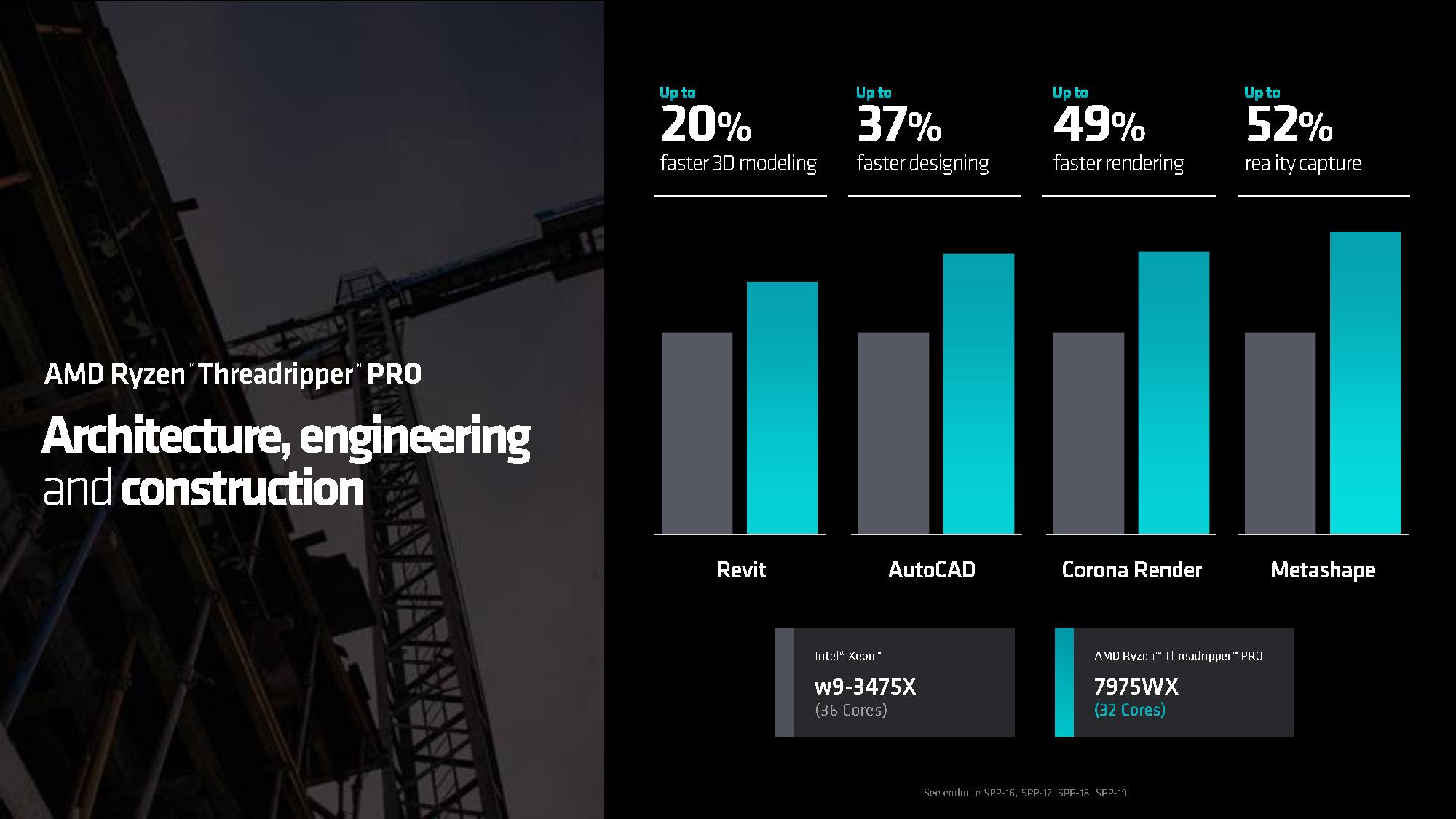
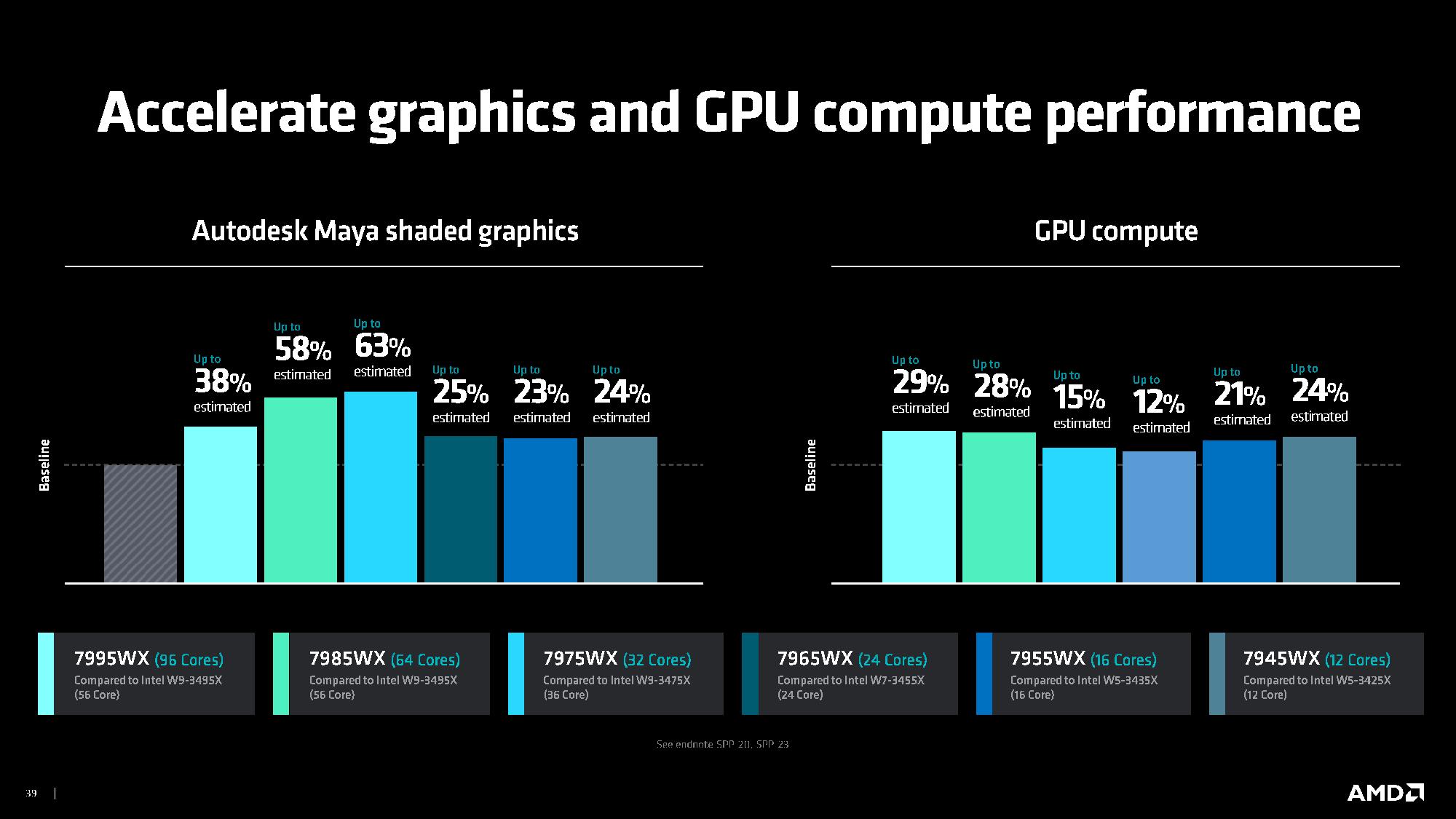
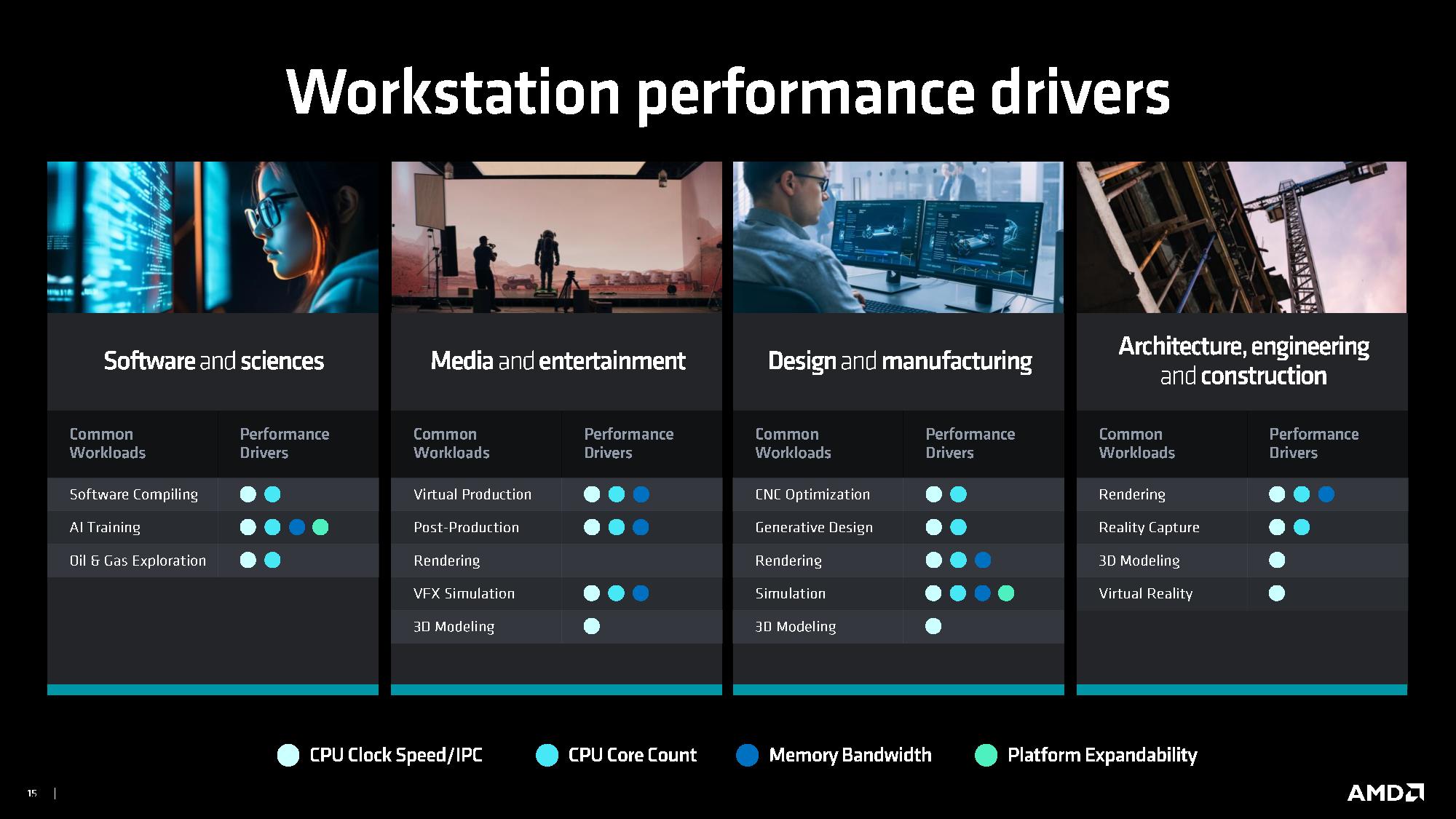

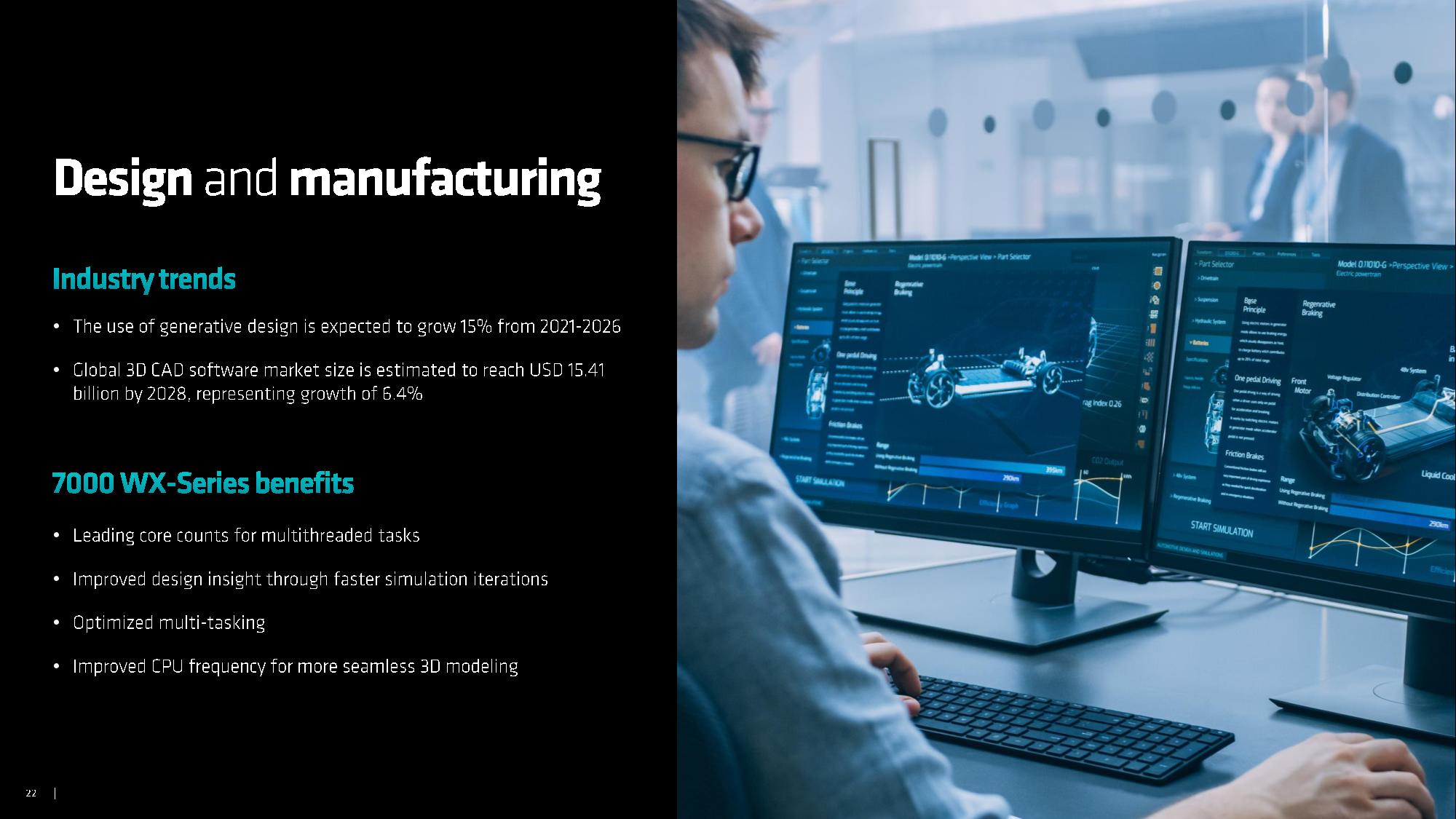
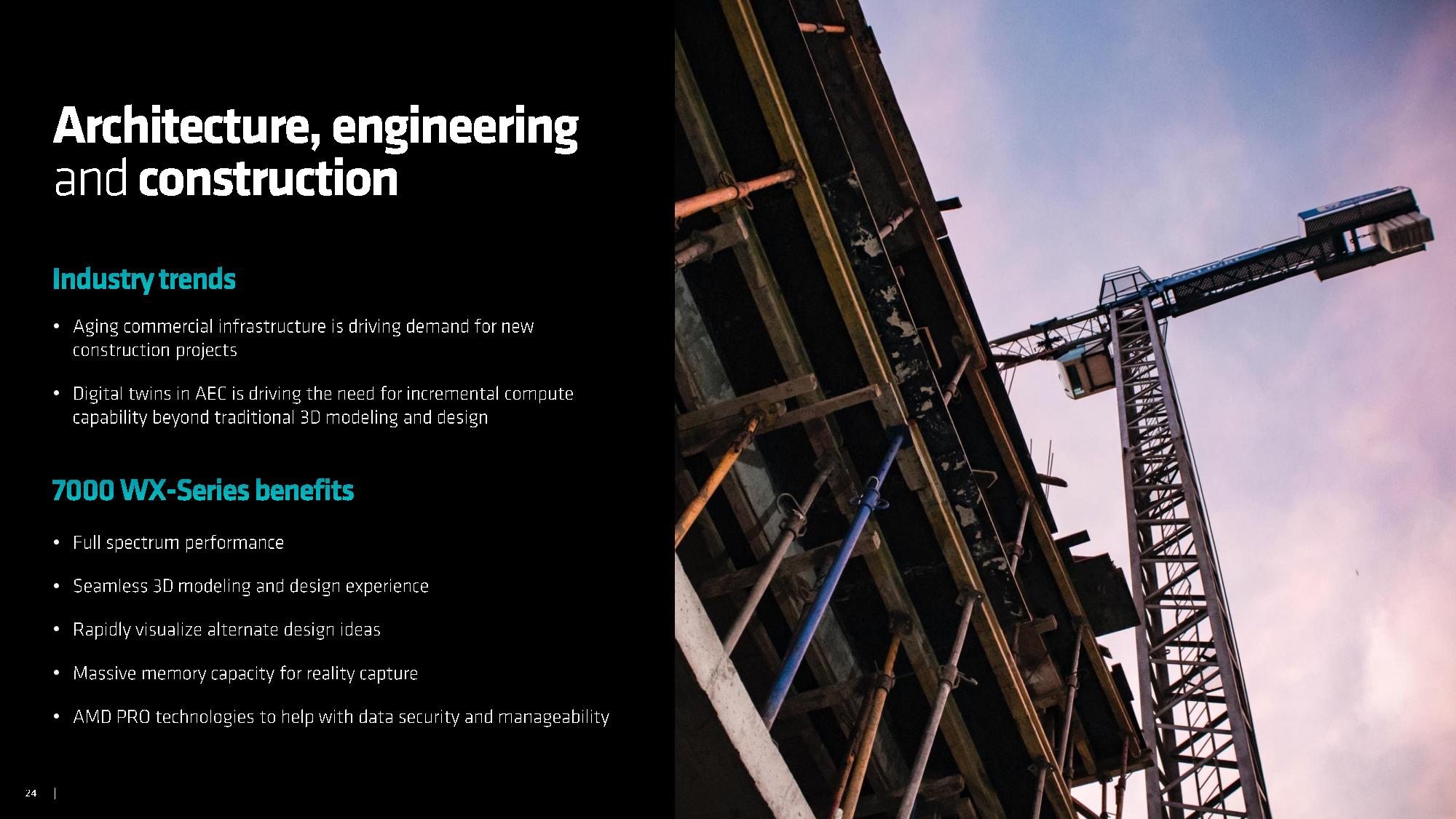
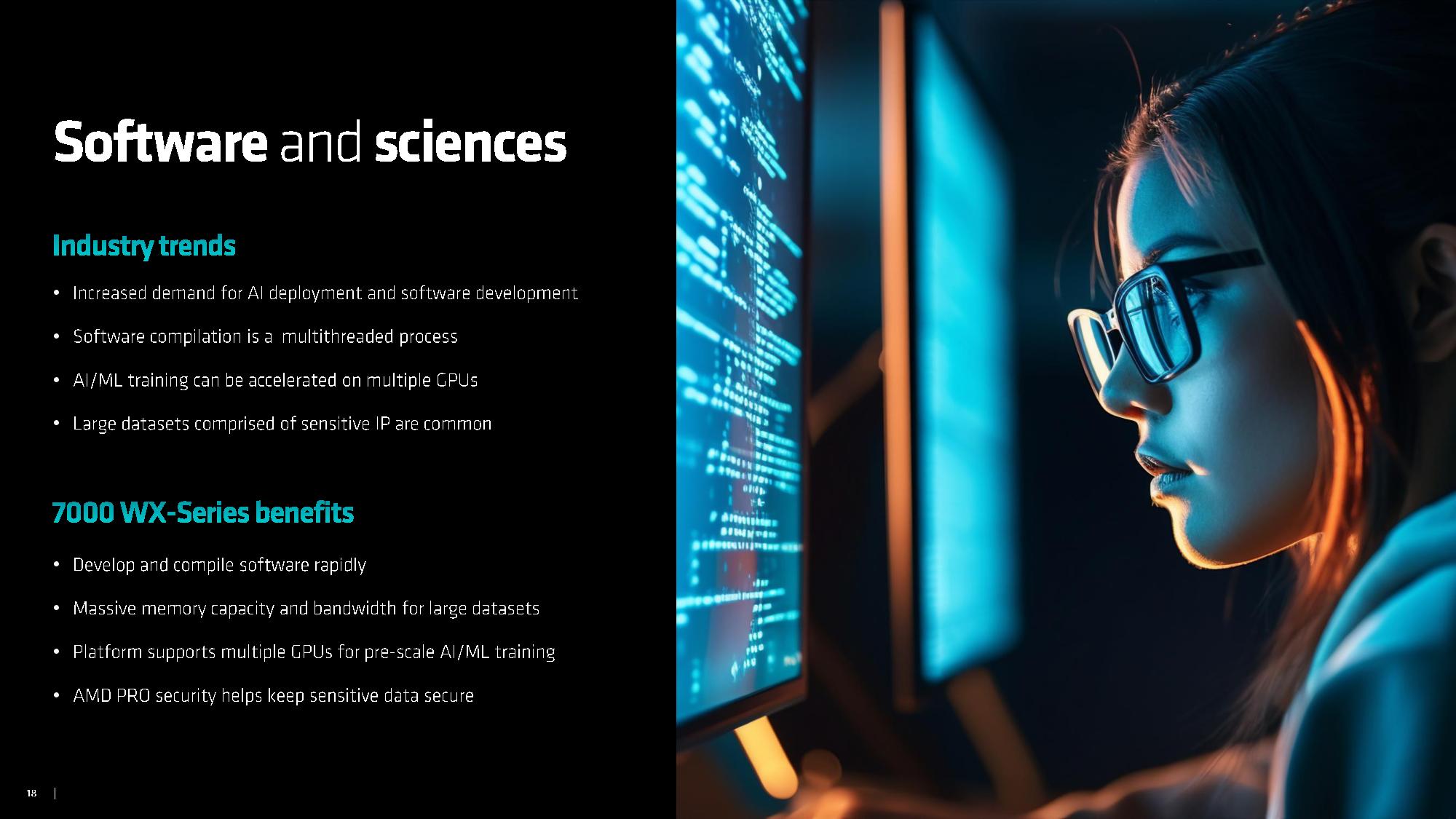
AMD shared an overwhelming amount of performance data for the Threadripper Pro series spanning the key verticals in the workstation market — software and sciences, media and entertainment, design and manufacturing, and architecture, engineering, and construction (AEC). AMD also had breakout sessions with representatives from several major software firms, like Ansys, Adobe, and PTC Creo, that presented their own performance data and touted AMD’s Threadripper as the hands-down fastest solution on the market. The company even demoed a large language model running live on a Threadripper Pro processor.
AMD’s Threadripper obviously comes with plenty of threaded heft for the most demanding parallelized applications, but the company also prioritized increasing its performance in single- and lightly-threaded workloads, which can be a pain point in complex workloads that have multiple phases of varying types of compute. As you can see in the first slide of the above album, AMD says this focus on developing a balanced design has led to superior performance, often by huge margins, across the full breadth of its product stack, beating Intel’s processors core-for-core with every SKU.
Ryzen Threadripper 7000-Series Architecture
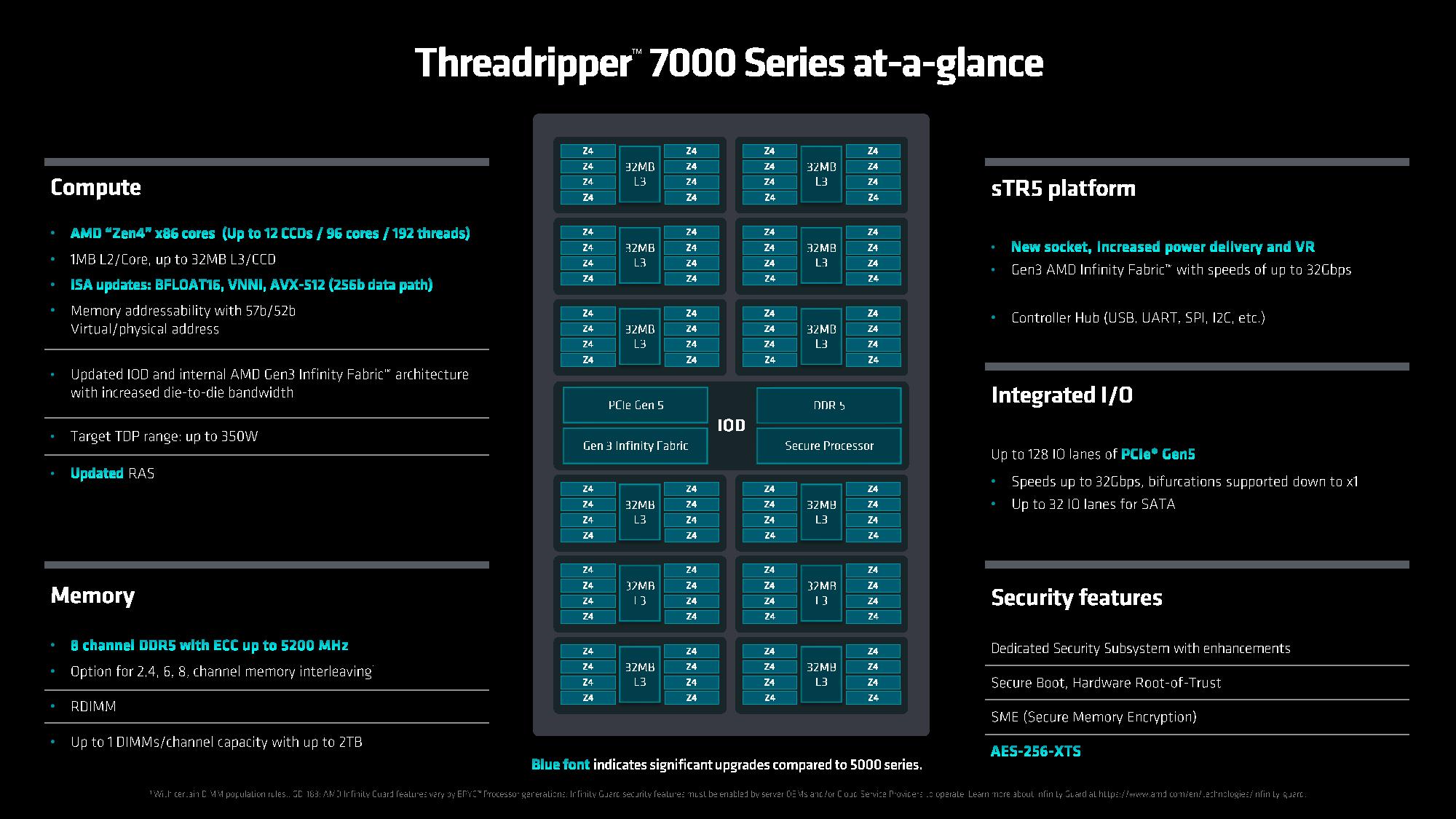
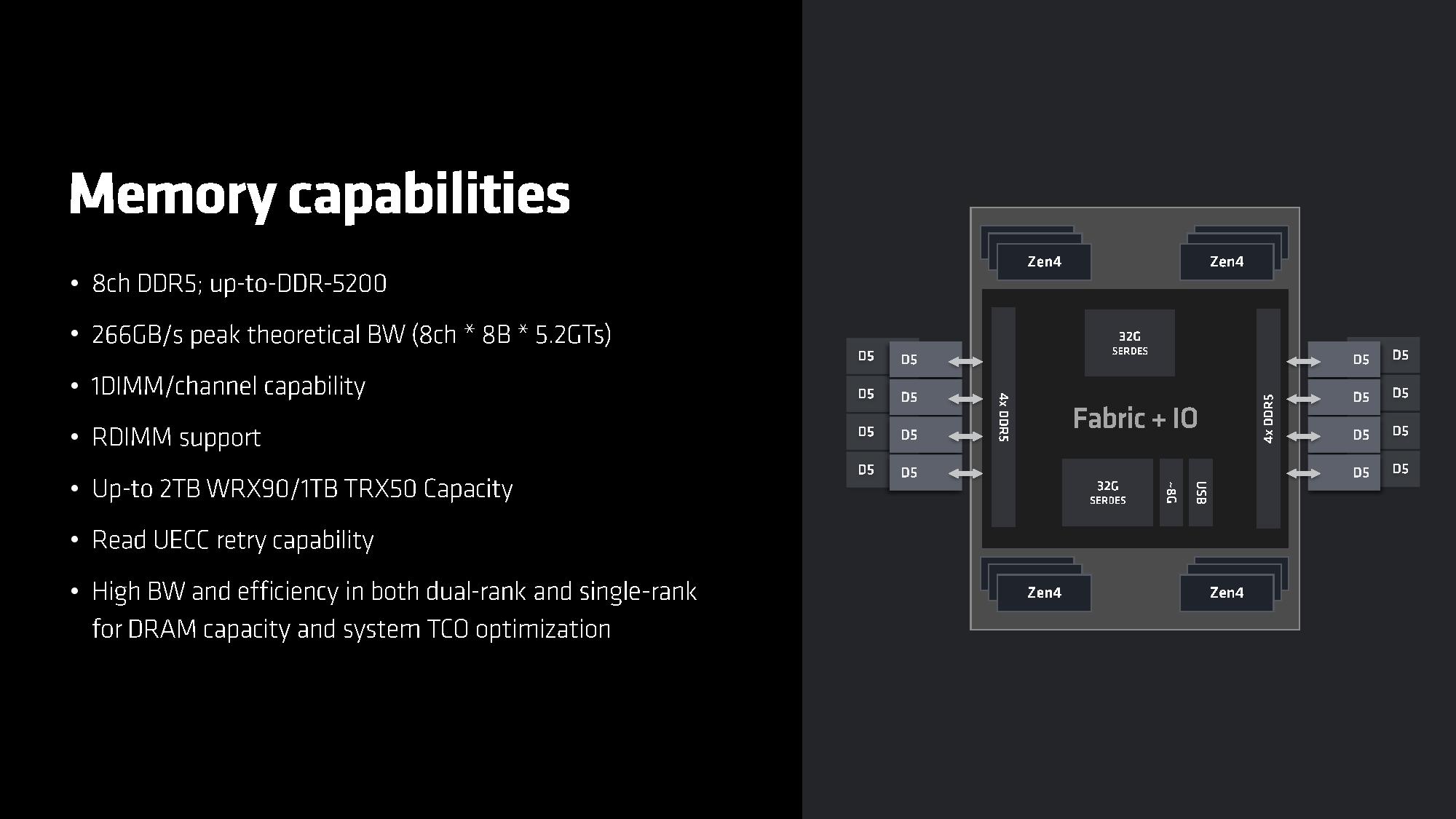
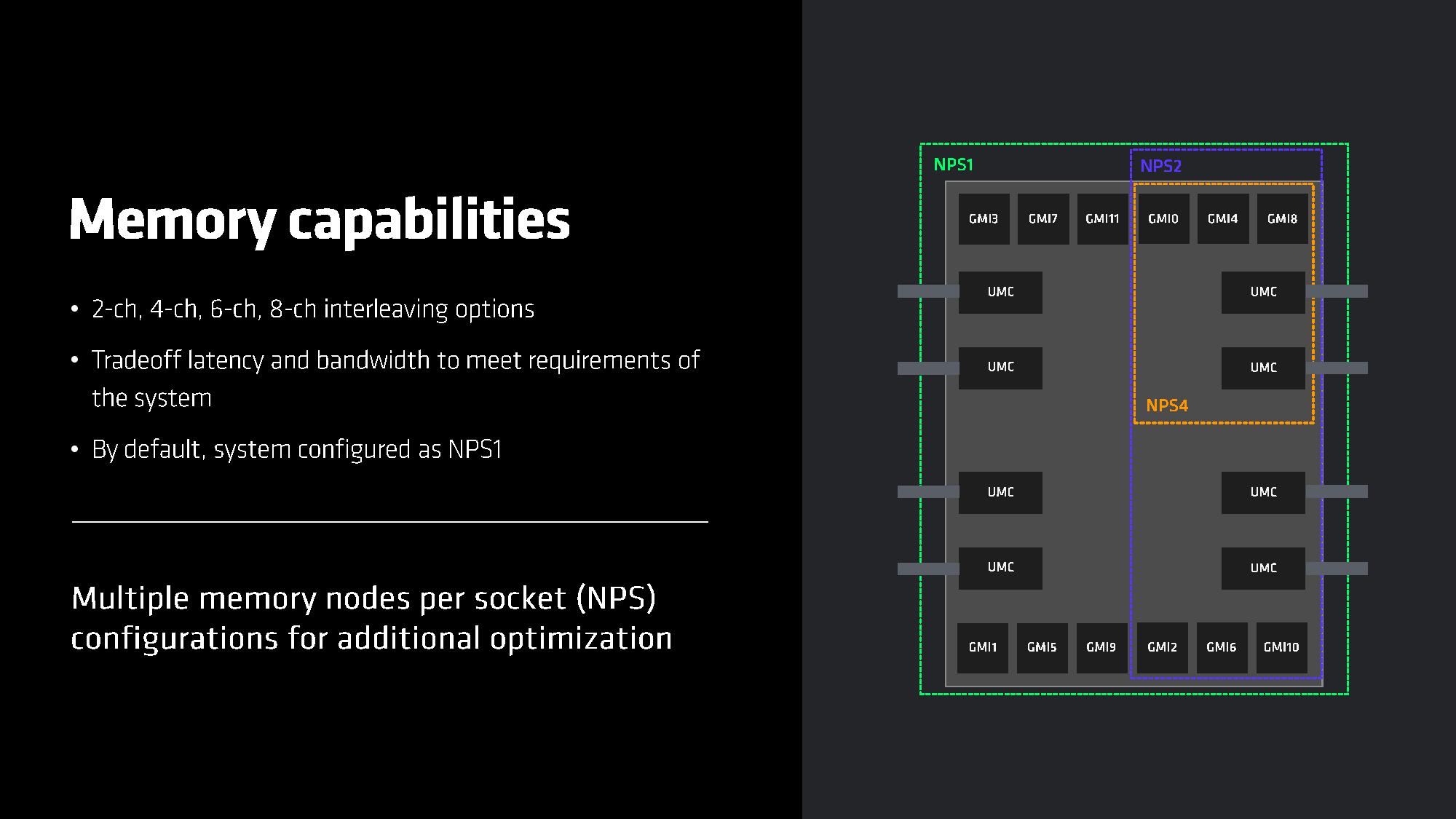
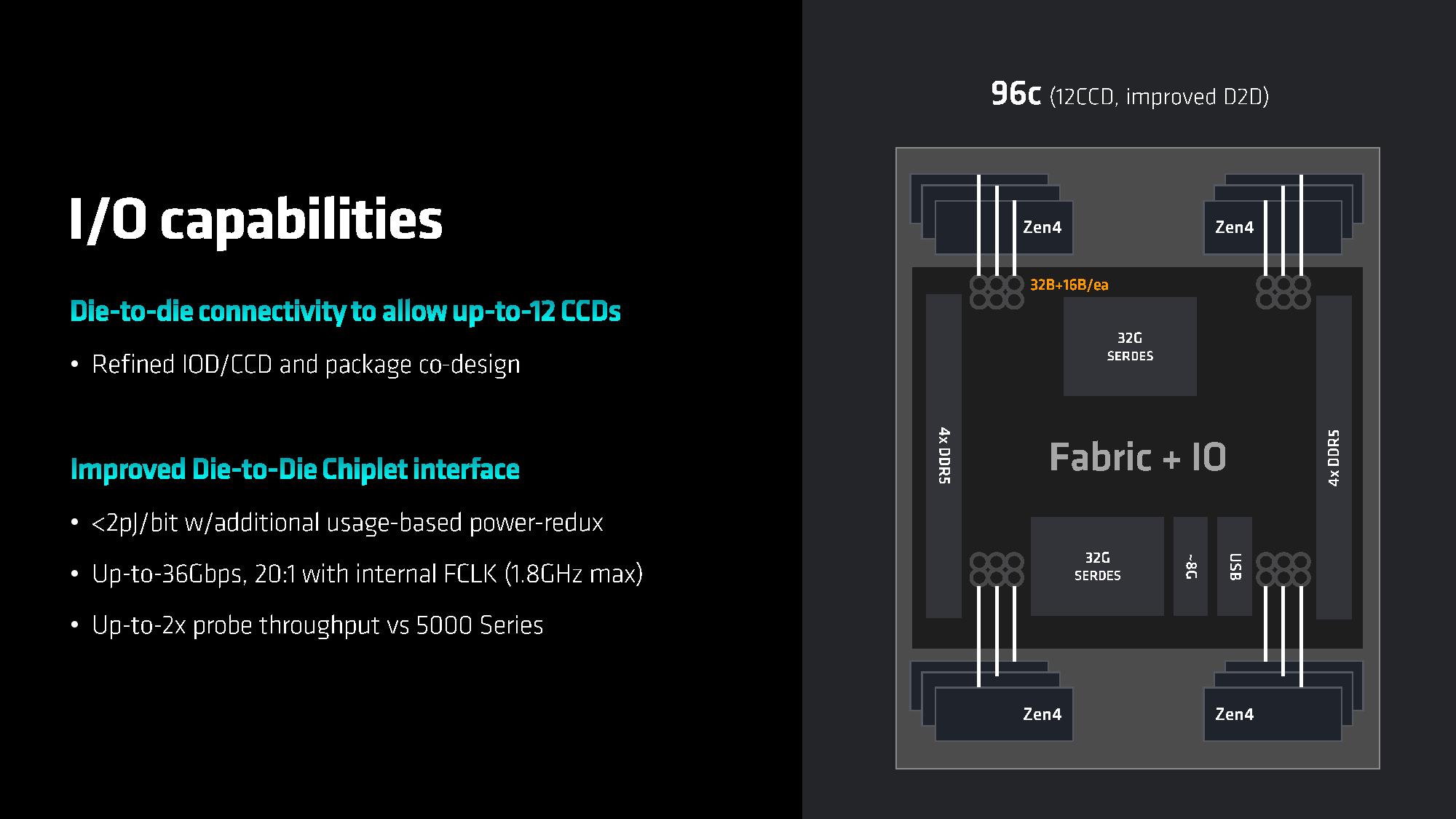
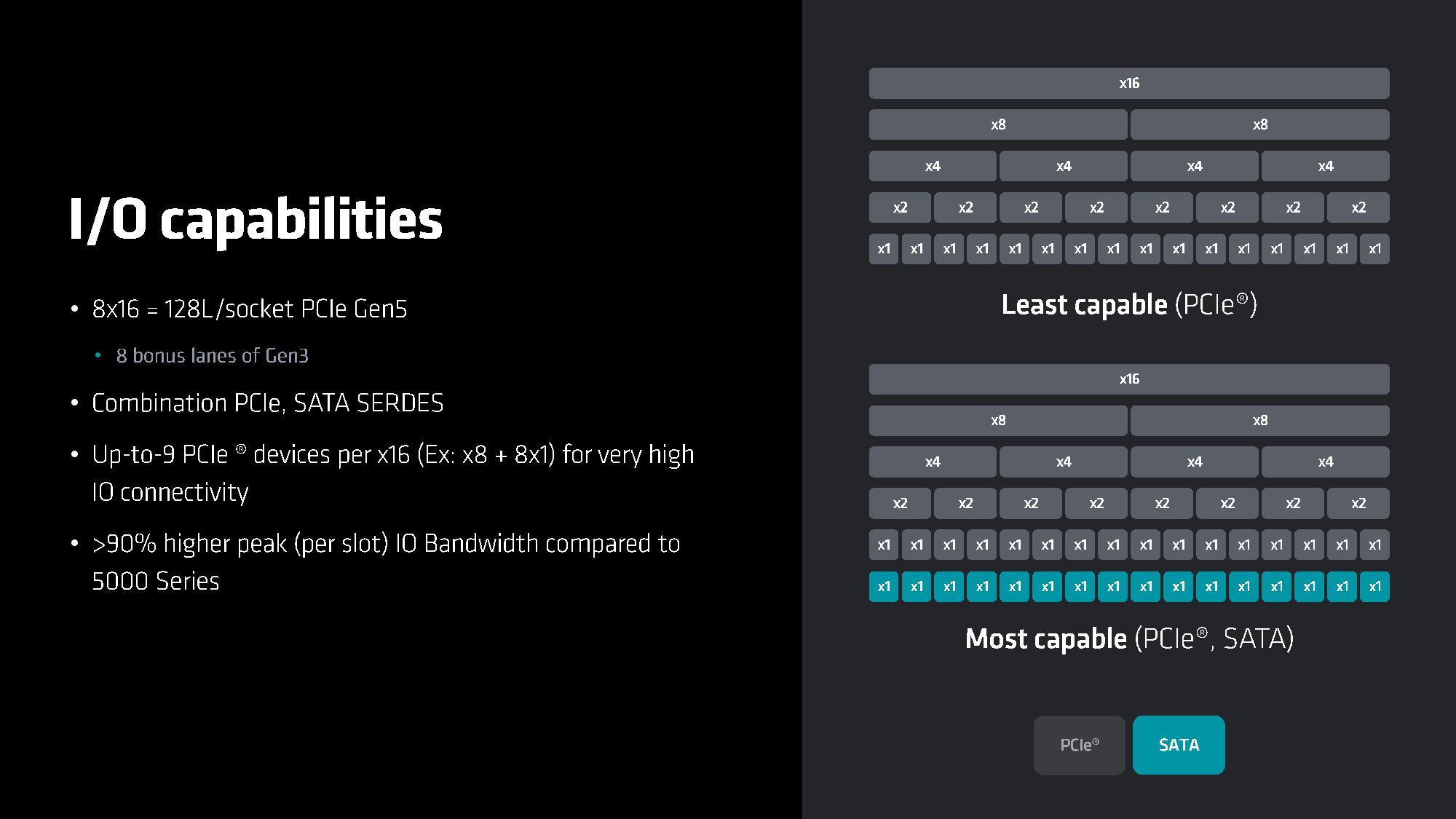
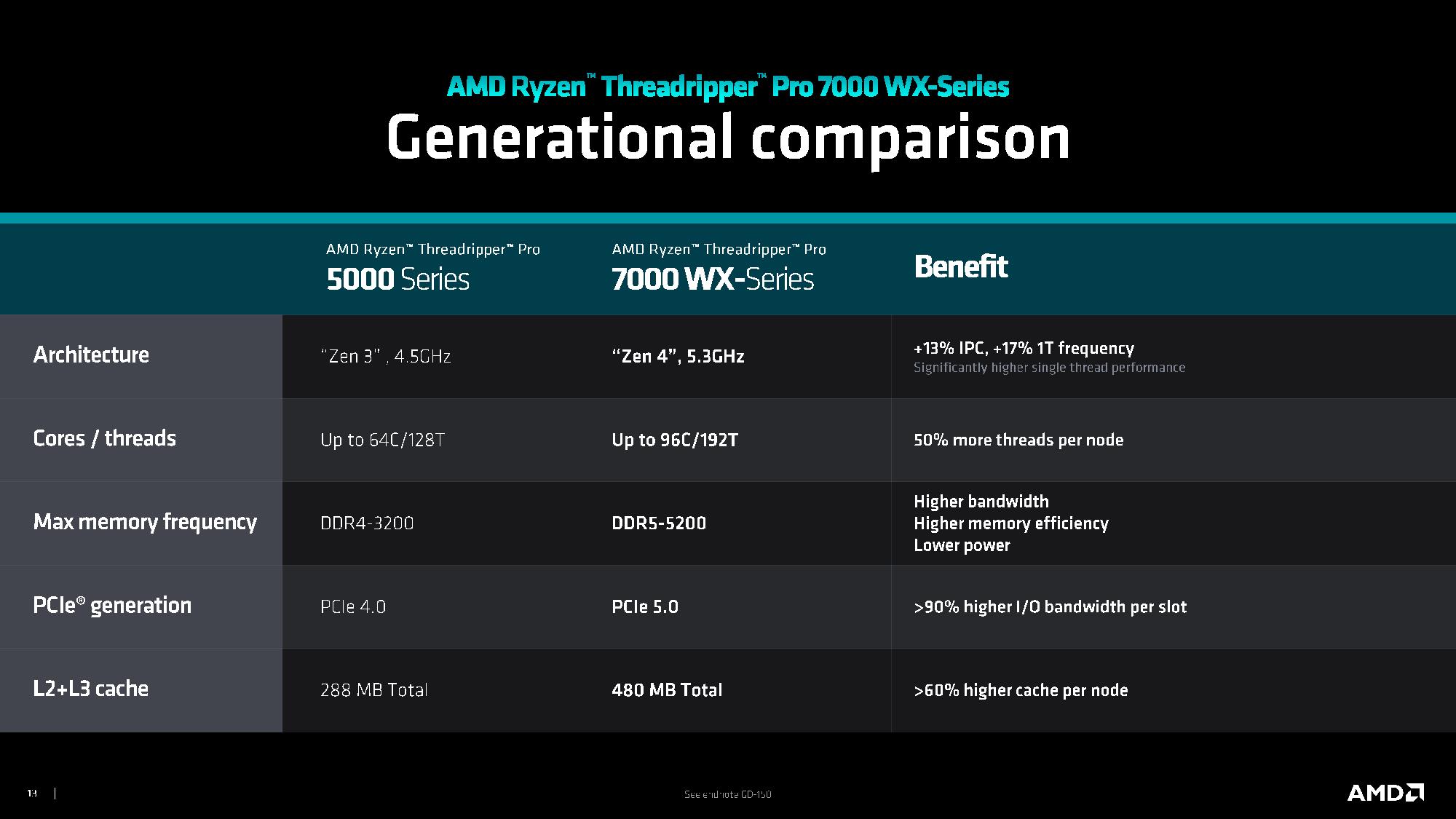
The new Threadripper processors benefit from all of the standard trimmings of the Zen 4 architecture, like a 13% IPC increase and support for AVX-512, Bfloat16, and VNNI. As noted, the chips support DDR5-5200 RDMIMMs, but AMD has limited the platform to 1DPC to maximize the achievable memory speeds and reduce the system footprint.
As with the data center processors, AMD allows users to carve the chip up into different NPS configurations, thus confining memory access to certain groups of cores, thus reducing loaded memory latency. This boosts performance in several types of workloads.
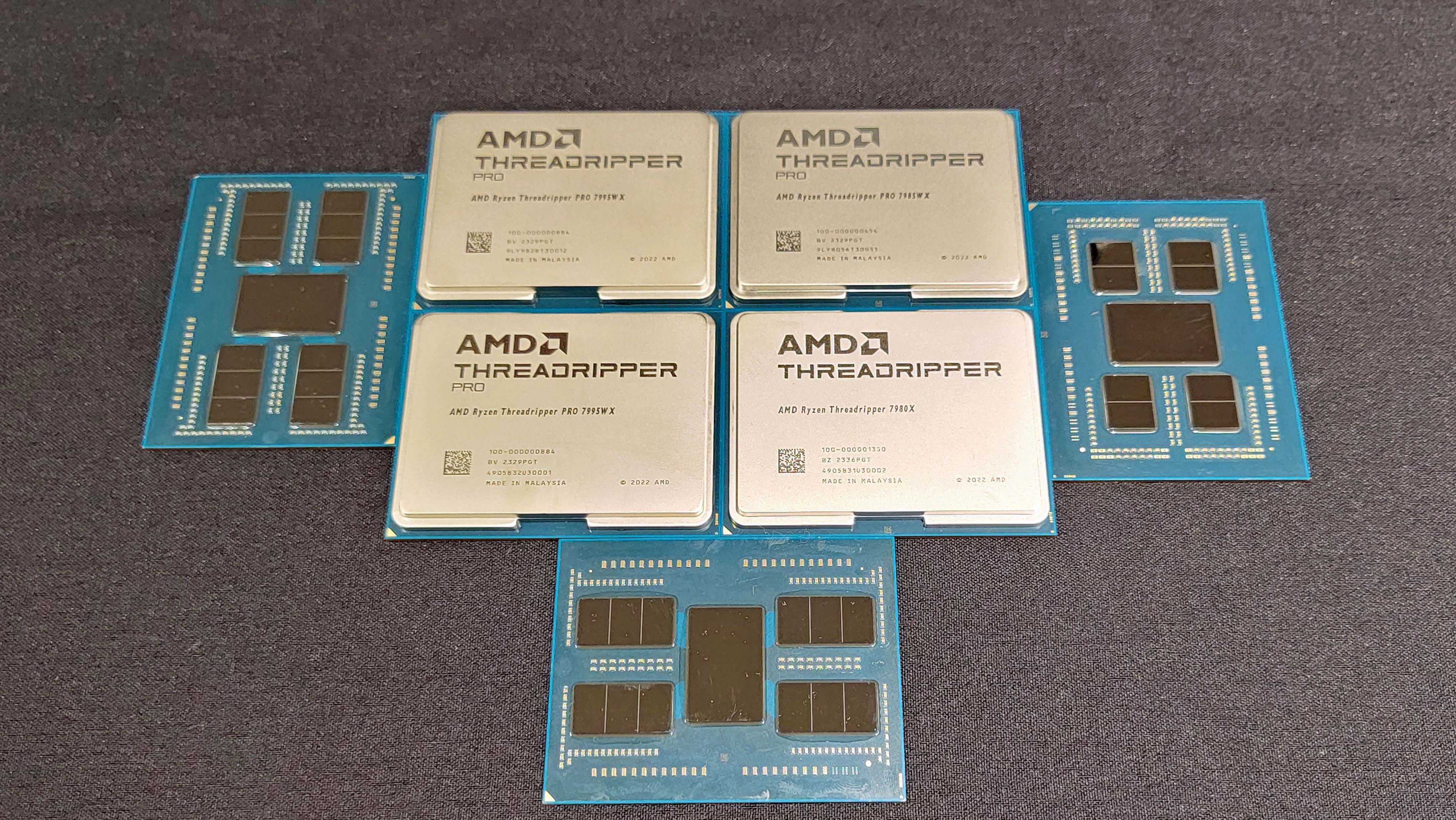
The processors feature either 8 or 12 Core Compute Die (CCD) configurations, with each CCD containing the standard eight processing cores that we see with other Zen 4 models. AMD uses the same 6nm I/O Die (IOD) that it uses for its EPYC Genoa processors, but parts of the die aren’t used, like the extra four memory controllers used in the data center processors. AMD also disabled CXL connectivity, as it doesn’t feel there is a need for that capability with workstation/HEDT platforms.
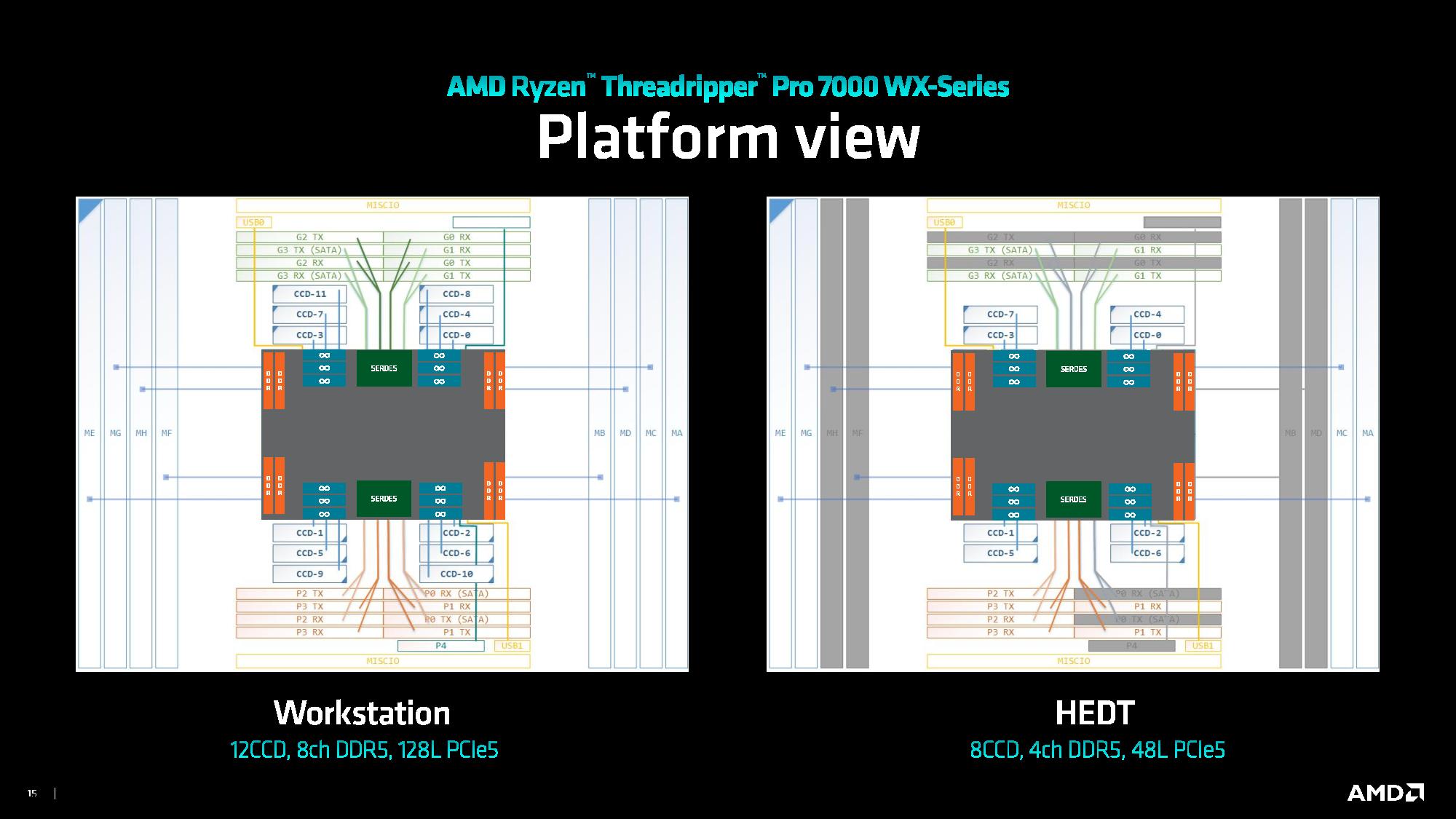
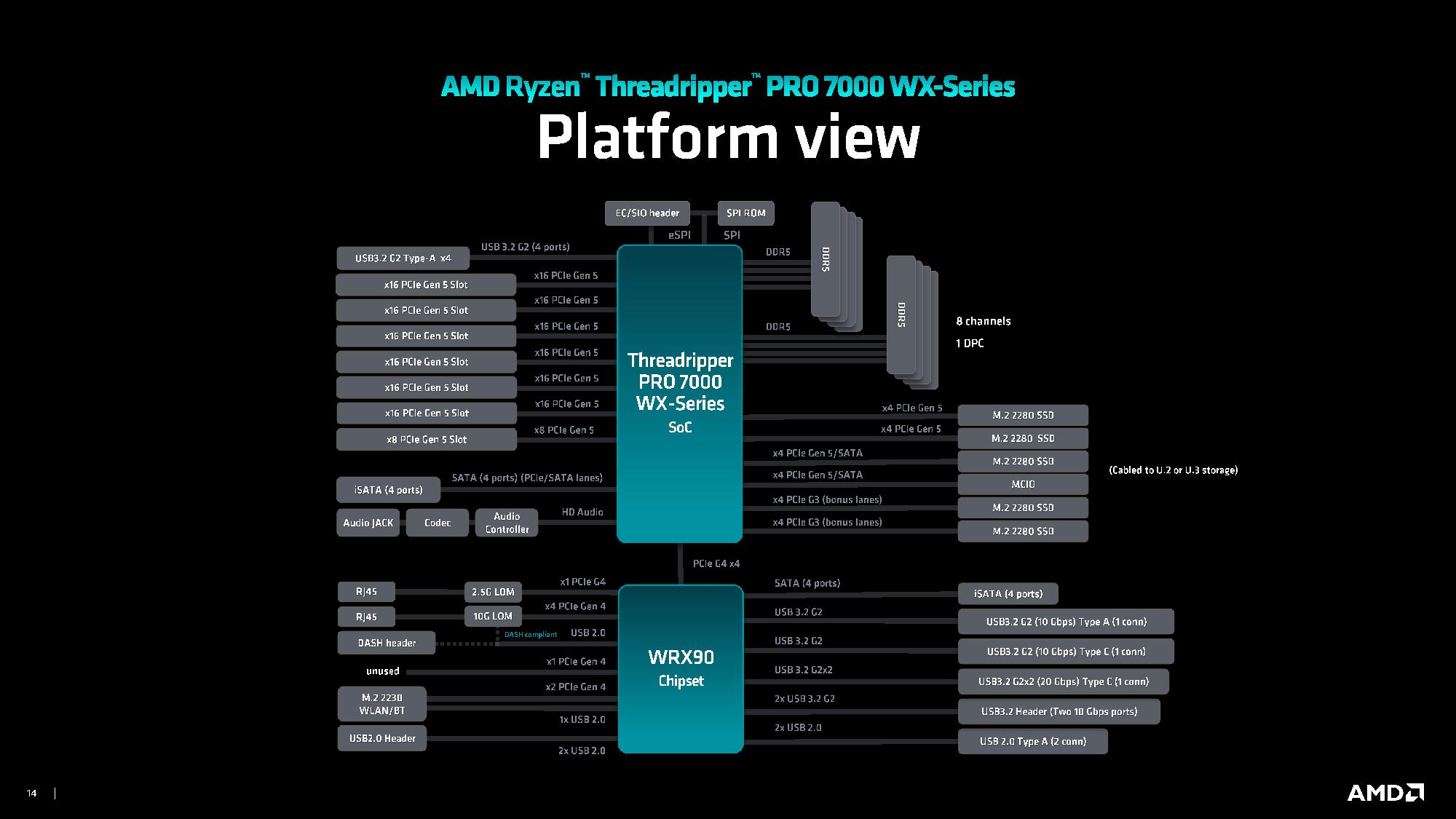
As mentioned, AMD’s processors drop into the sTR5 socket on TRX50 and WRX90 platforms. The socket is physically the same size (58.5 x 75.4mm – 4410.9mm^2) as the SP6 socket that AMD recently introduced with its EPYC Sienna CPUs and features the same allotment of 4844 pins. It’s also the same size as the sTRX4/SP3 socket found with the previous-gen Threadripper products, but the sockets aren’t electrically compatible – sTRX4 only has 4,094 pins, with sTR5’s additional pins dedicated to the upgraded DDR5 and PCIe 5.0 interfaces. In either case, AMD's ability to cram in 96 cores into the same sized package is an impressive feat.
That means you won’t be able to drop a 7000-series Threadripper into the previous-gen WRX80/TRX40 platforms, but existing coolers and mounting mechanisms designed for those sockets will work with the new Threadripper processors.
AMD’s Return to HEDT
AMD essentially ran Intel out of the HEDT market with its Threadripper 3000 processors, which provided an unprecedented level of performance for high end desktops that Intel simply couldn’t match. AMD’s decision to then exit that market was met with plenty of criticism from enthusiasts. AMD’s re-entry does look promising with a cut-down TRX50 platform that’s designed to reduce costs compared to full-featured workstations. Still, the new Threadripper 7000 CPUs command stiff premiums, not to mention the costs associated with ECC DDR5 memory, which will certainly relegate it to the prosumer and professional markets. AMD says this shift in focus will create differentiated products for that specific market segment, but it appears that what we would have traditionally considered an HEDT platform for enthusiasts will remain out of reach for most. However, AMD sparked a core war with Intel, resulting in mainstream processors that already feature more than enough horsepower for the overwhelming majority of enthusiasts.
Given the benchmarks we’ve seen in person at AMD’s event, the Threadripper Pro 7000 WX-series and Ryzen Threadripper 7000-series will offer unparalleled performance and capabilities that leave Intel’s current platforms firmly in the rearview mirror. Intel will likely release its own competing new Xeon W platforms based on its next-gen server chip designs in the future, but AMD’s Threadripper appears to have set an incredibly high bar that will be tough to match.
As you’d imagine, with full retail availability of both Threadripper CPUs and OEM workstations coming on November 21, we’ll soon see reviews that suss out the performance details.
- MORE: Best CPUs for Gaming
- MORE: CPU Benchmark Hierarchy
- MORE: AMD vs Intel
- MORE: All CPUs Content

Paul Alcorn is the Editor-in-Chief for Tom's Hardware US. He also writes news and reviews on CPUs, storage, and enterprise hardware.
-
floored63 Reply
It'd be interesting to see, but tf2 responds better to higher clocks not more coresbolweval said:Bet that thing would play Team Fortress 2 like nobody's business! -
Order 66 My prediction was partly true! Back when rumors were circulating about these chips, I said that I hoped that at least some of these chips had 4+ GHz base clocks and some of them do. I am excited to see how the 7970x performs in cinebench r23.Reply -
Alvar "Miles" Udell If only Ryzen had the PCIE lanes of Threadripper...Or if the base model Threadripper wasn't so exorbitant. The 7945WX would make a killer long term investment, but not for 3x the price of the highest end Ryzen.Reply -
vertuallinsanity Hey Mike..Reply
You may want to fix the Model Specifications section of the spoofed page below. The scaling is incorrect for the scrolling list design on mobile and desktop browsers. Cheers!
https://www.amd.com/en/processors/ryzen-threadripper-pro
u mad bro? -
domih Bye bye INTEL Sapphire Rapids WS, we barely knew you :ROFLMAO:Reply
The HEDT 7000 series uses the same pricing as the HEDT 3000 series :cool:
New mobos and ECC memory: no biggy when your TCO is between $5,000~$10,000 👍 -
thestryker No doubt the platform price of entry is going to be high here, but it's nice to see both Threadripper lines coming back. I'm pleasantly surprised that AMD didn't raise the prices (on regular TR) to match Intel, and hopefully that'll force Intel to lower theirs (w7-2495X being ~$2200) with the forthcoming EMR release.Reply -
jasonf2 I am seeing that the non pro lineup is being put out as a HEDT market segment. While bragging rights are obvious is there anything that will scale to these core counts other than workstation workloads? And of those workloads can anyone justify the cost for the fairly limited reduction in render time from the sub $1000 chips and the framerate penalty from the lower clocks? I can absolutely see some workstation use cases, but at that level I would be leaning towards the pro anyways.Reply -
thestryker Reply
I said it with the SPR Xeon workstation chip launch and it's true here too: calling these HEDT is a misnomer as they're just budget workstations.jasonf2 said:I am seeing that the non pro lineup is being put out as a HEDT market segment. While bragging rights are obvious is there anything that will scale to these core counts other than workstation workloads? And of those workloads can anyone justify the cost for the fairly limited reduction in render time from the sub $1000 chips and the framerate penalty from the lower clocks? I can absolutely see some workstation use cases, but at that level I would be leaning towards the pro anyways.
That being said I can certainly understand why someone might opt for the TR over TR Pro. The price of entry difference between TR vs TR Pro is significant much like Xeon W. You'll have more expensive motherboards (Xeon price difference is $200-300 more for 8ch boards), higher minimum amount of DRAM to run the CPU optimally and then the CPU price itself. When all is said and done you're talking somewhere around $1500-1800 more minimum for a 24c TR Pro than 24c TR.